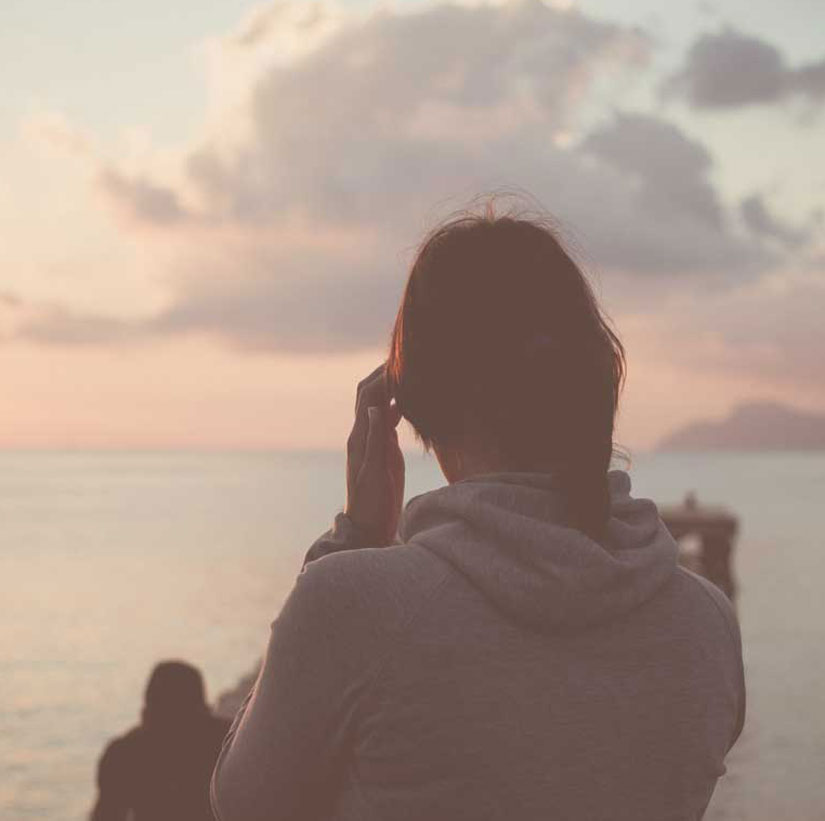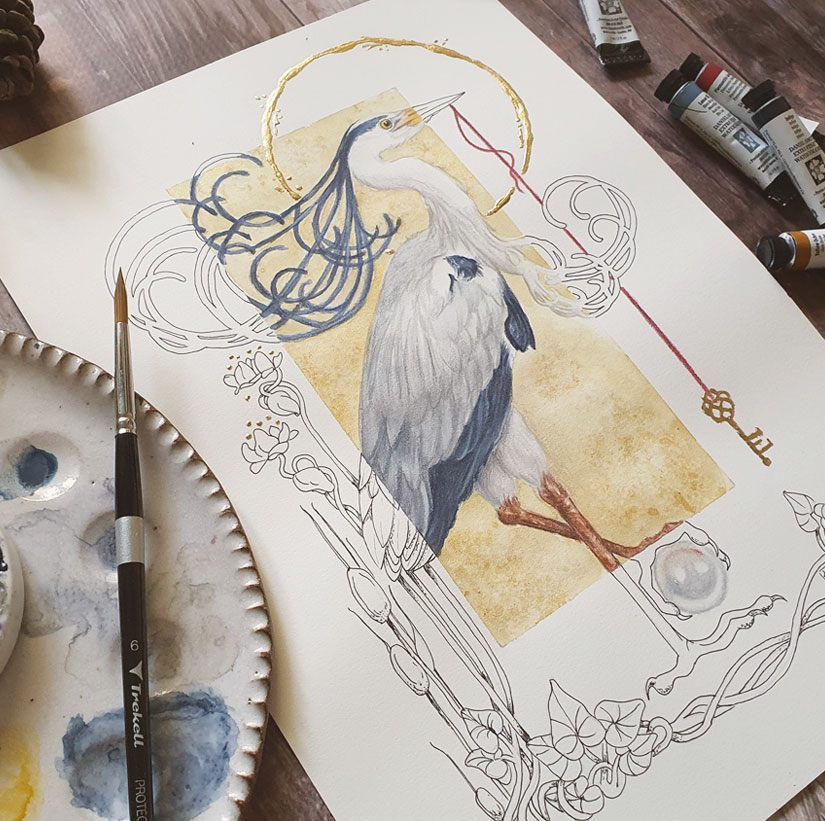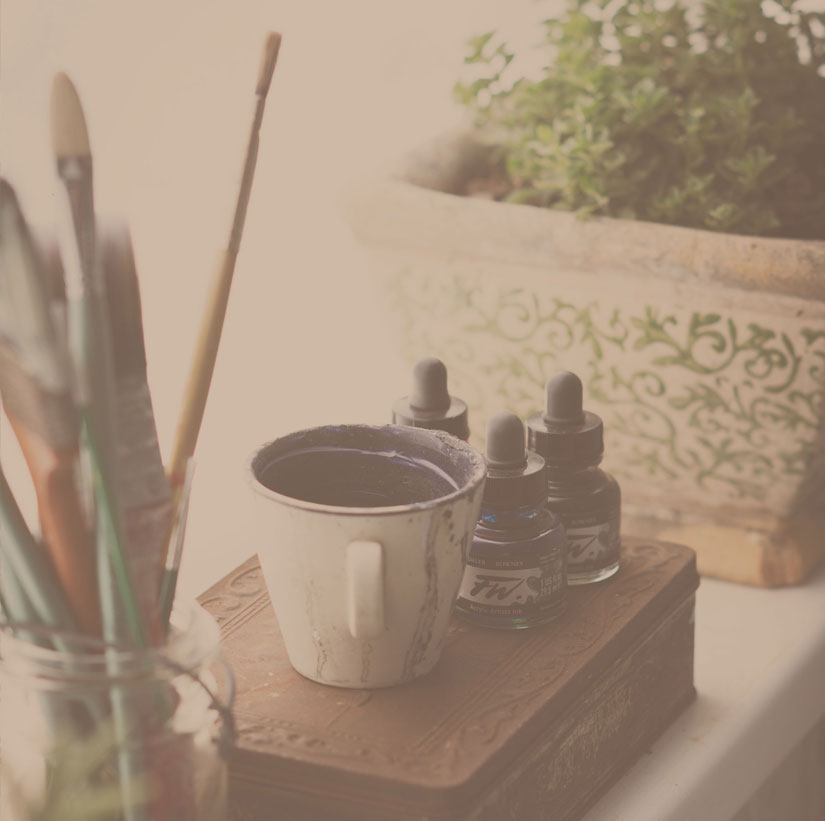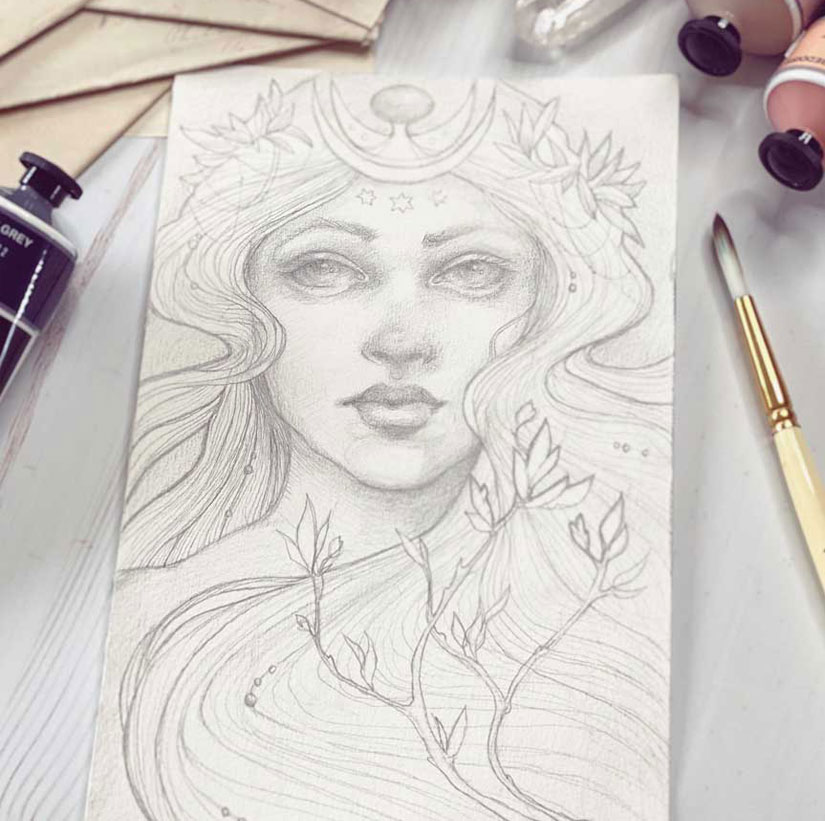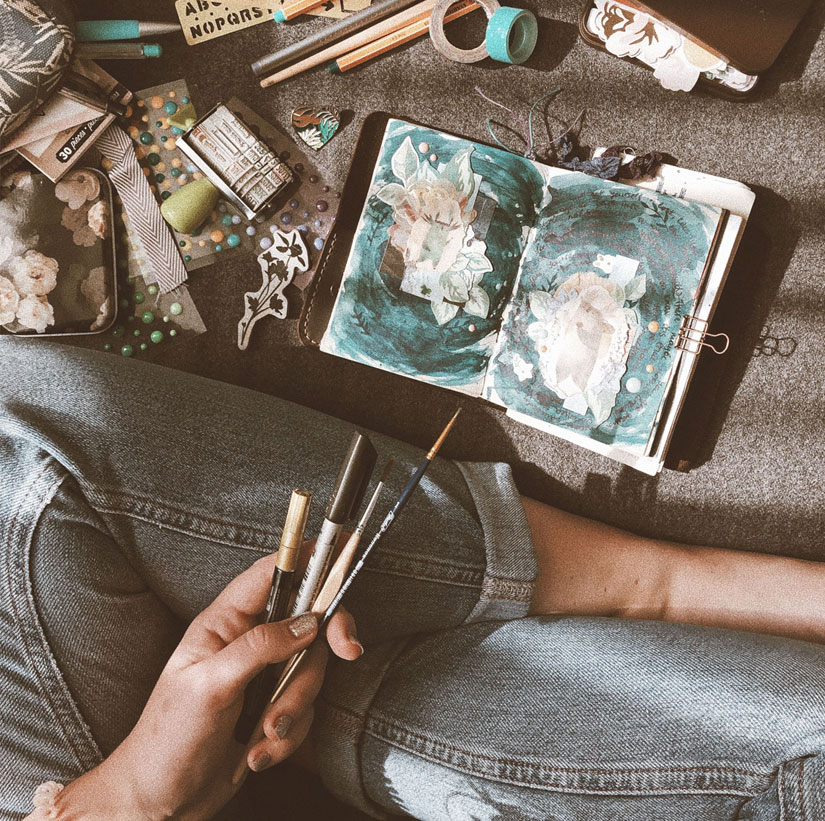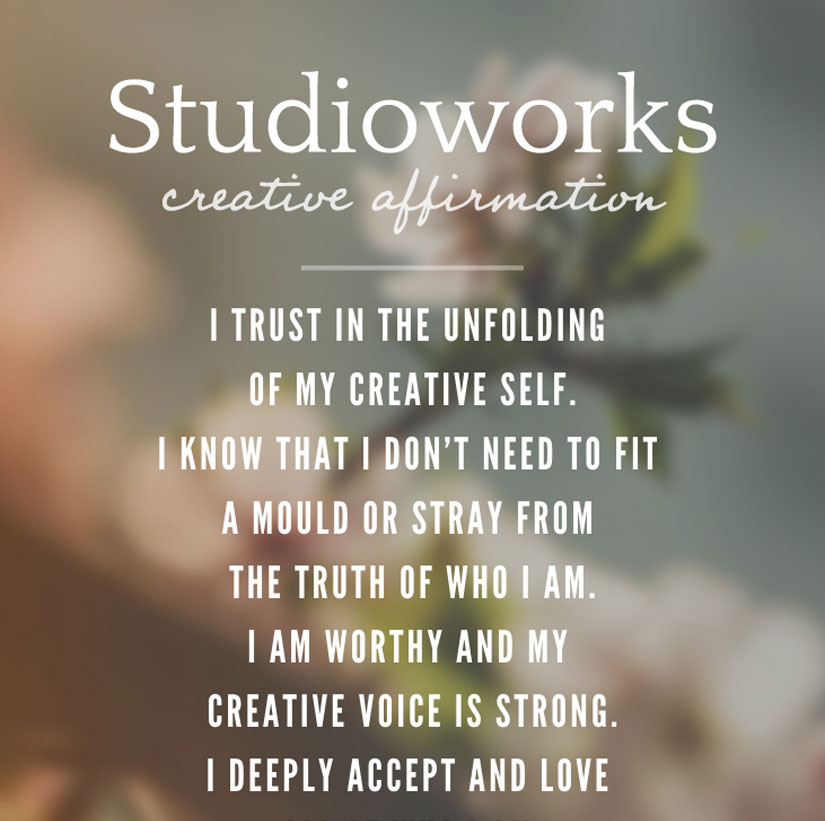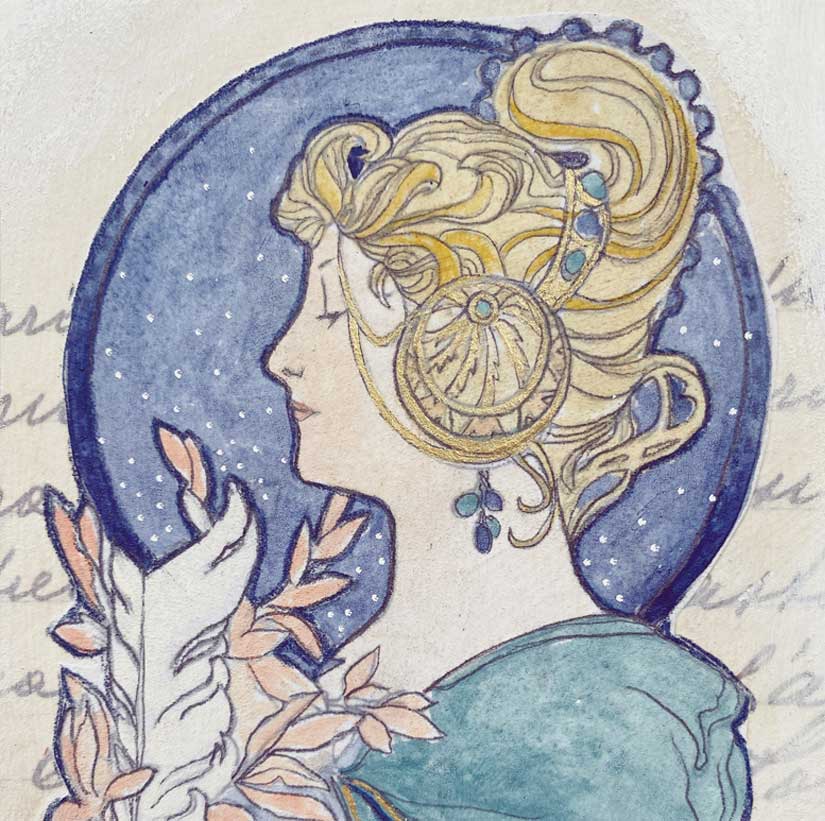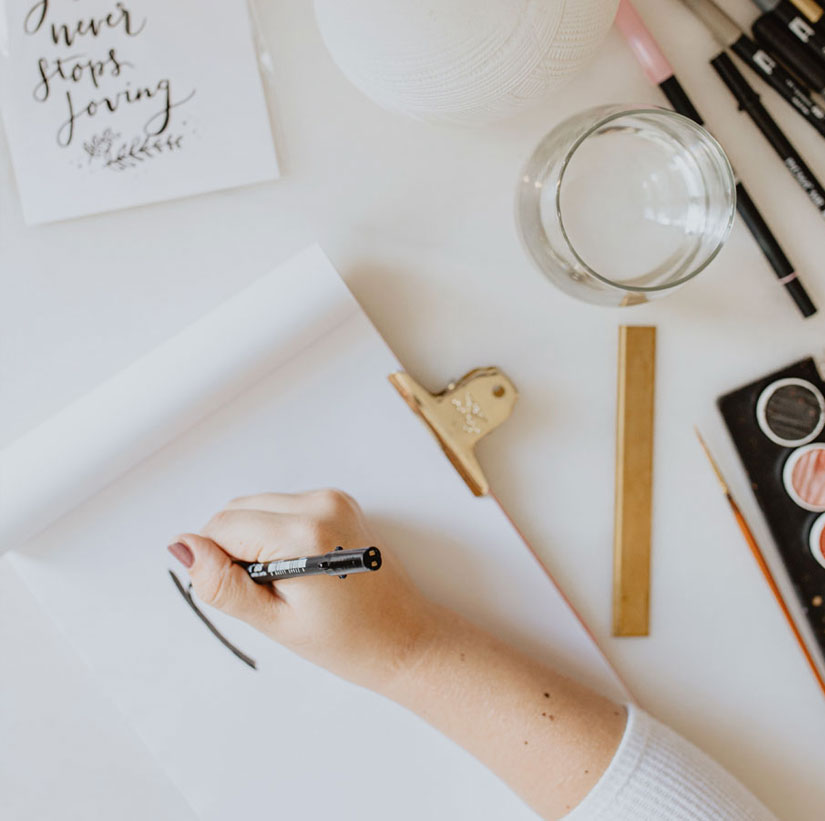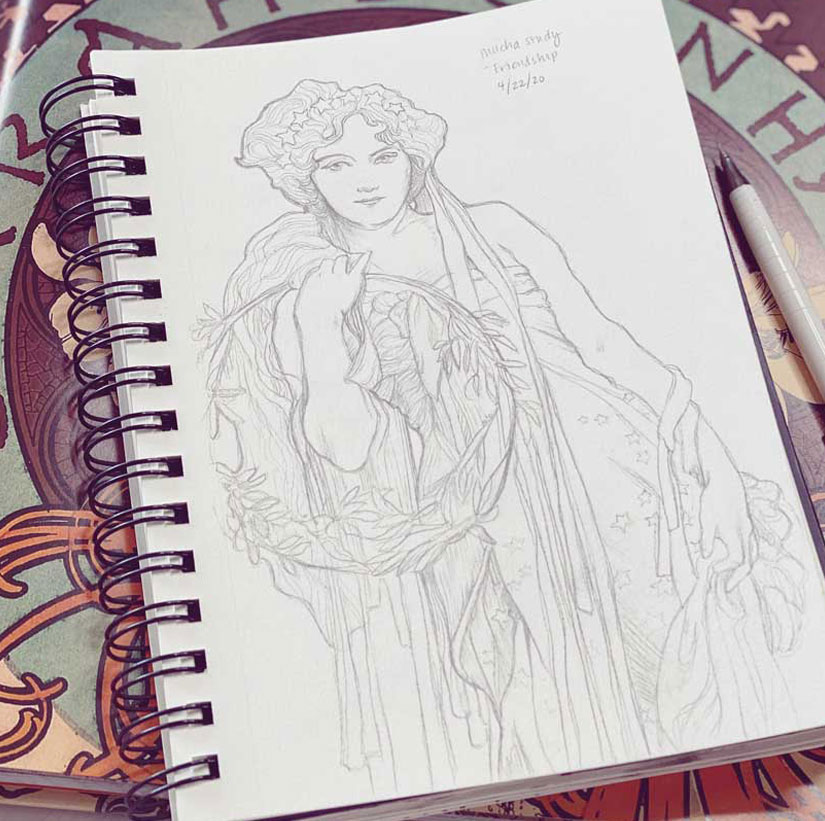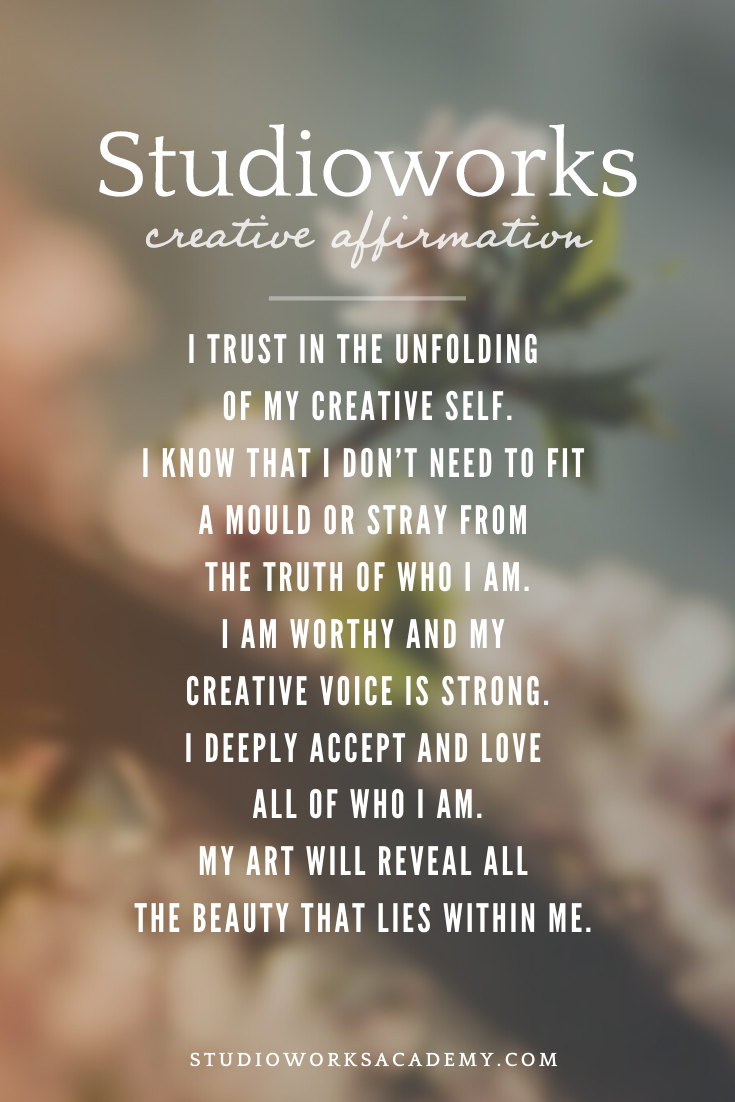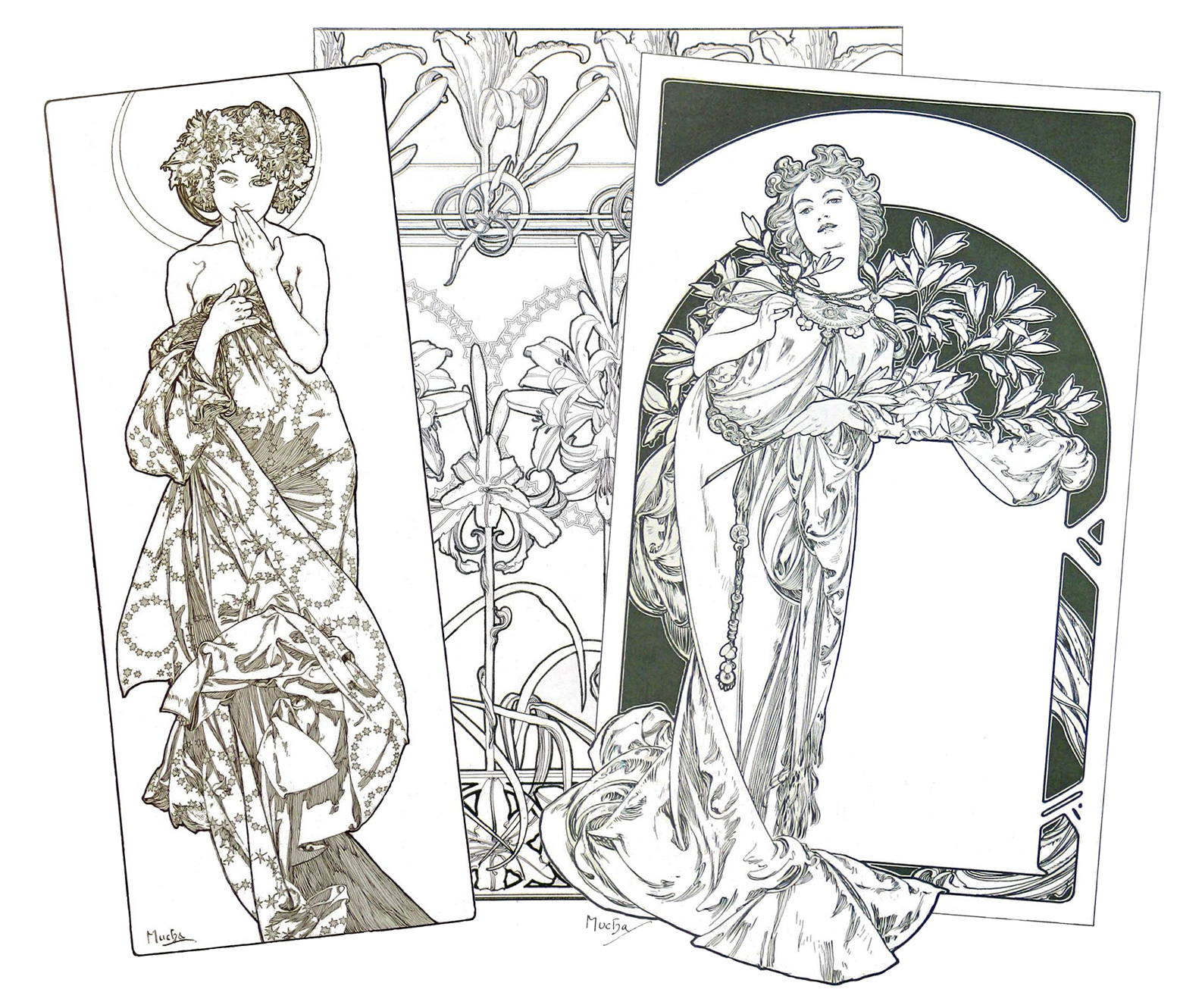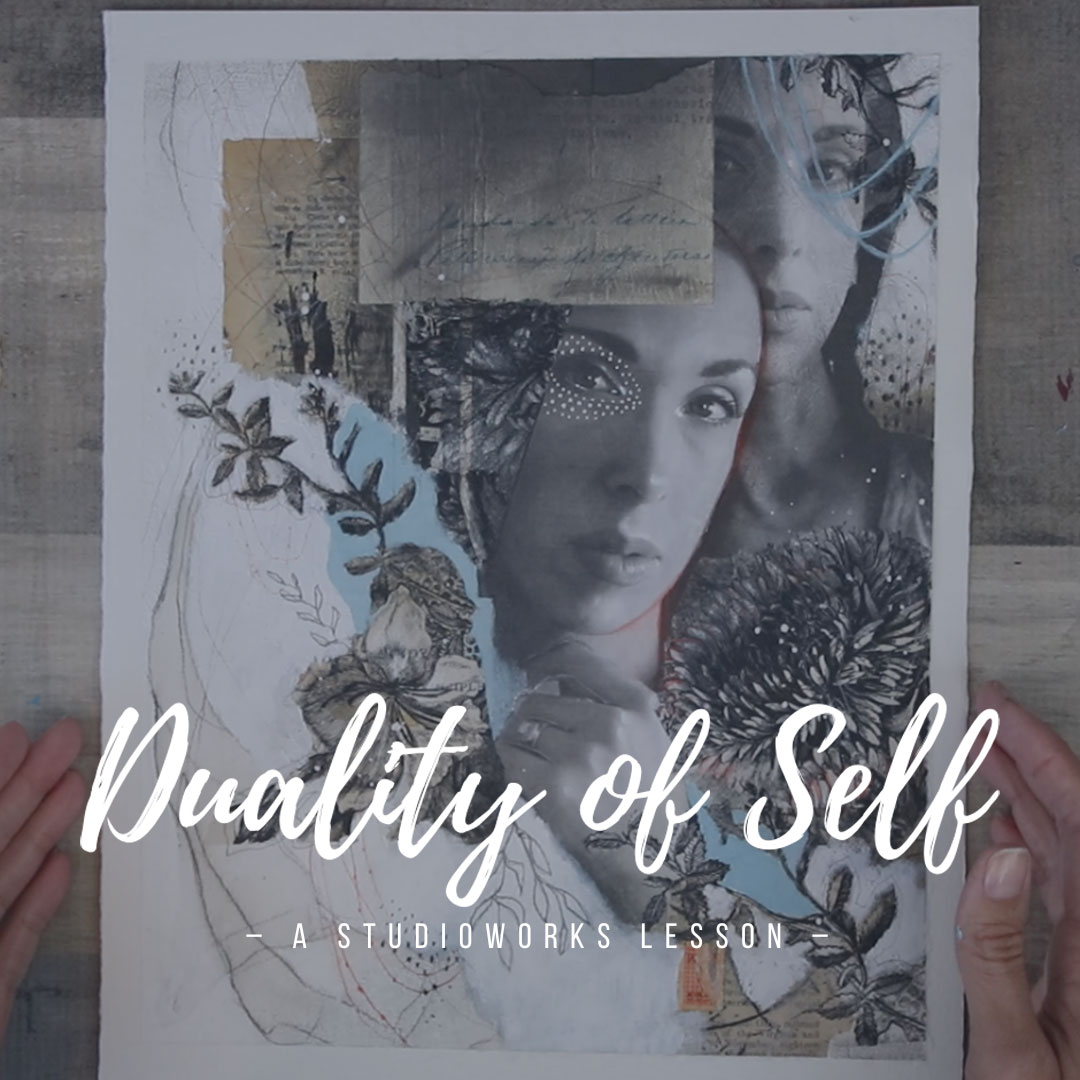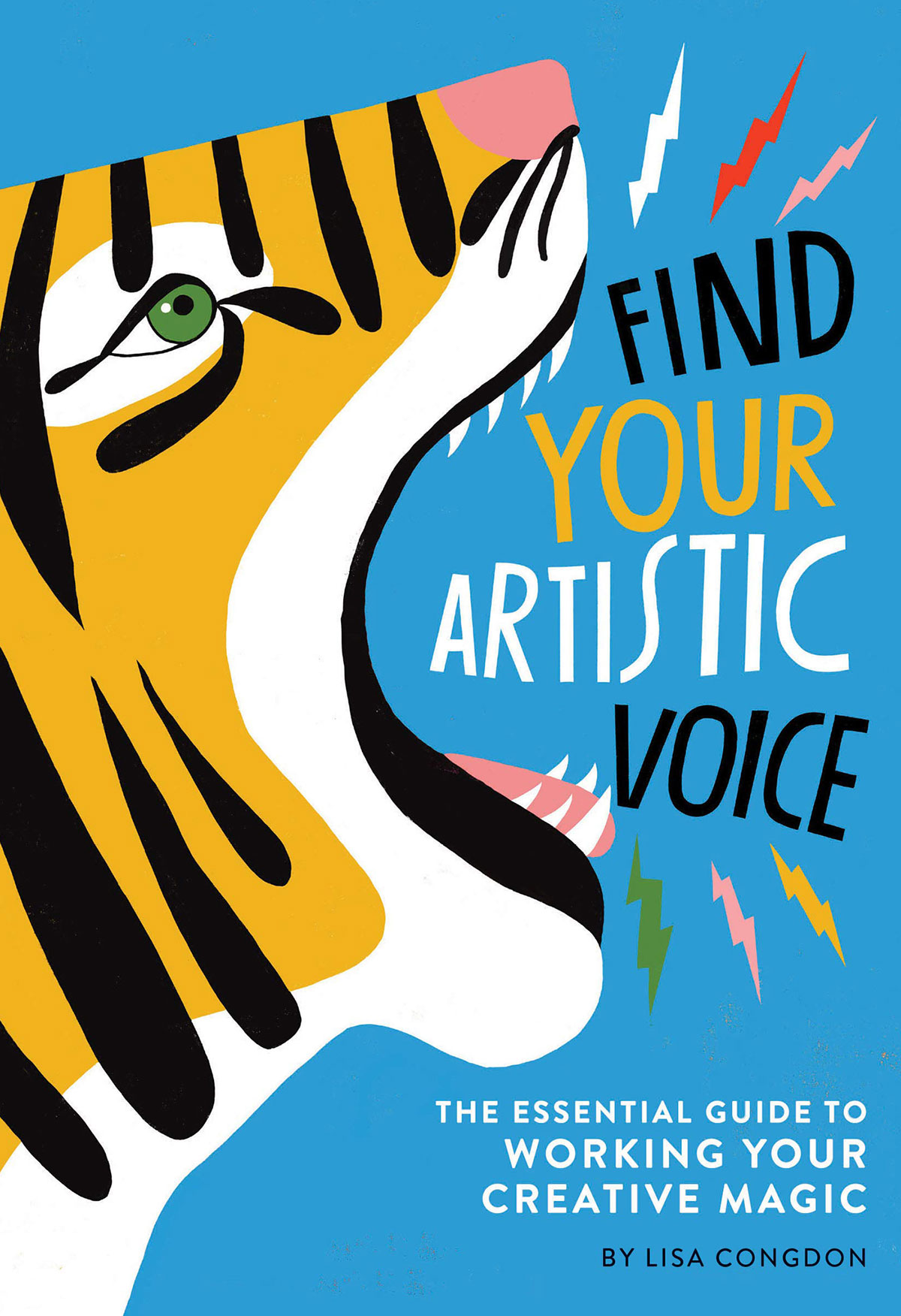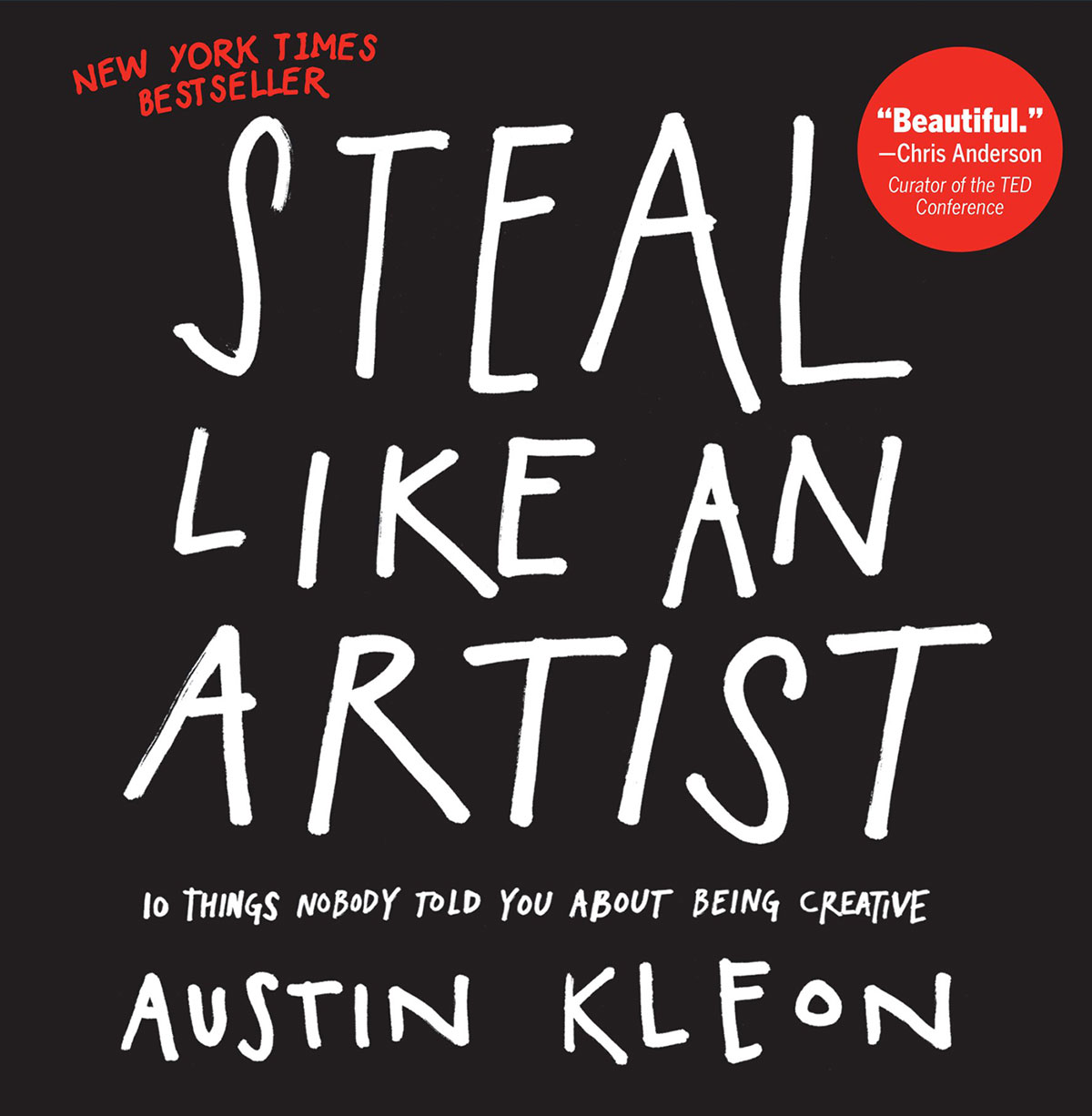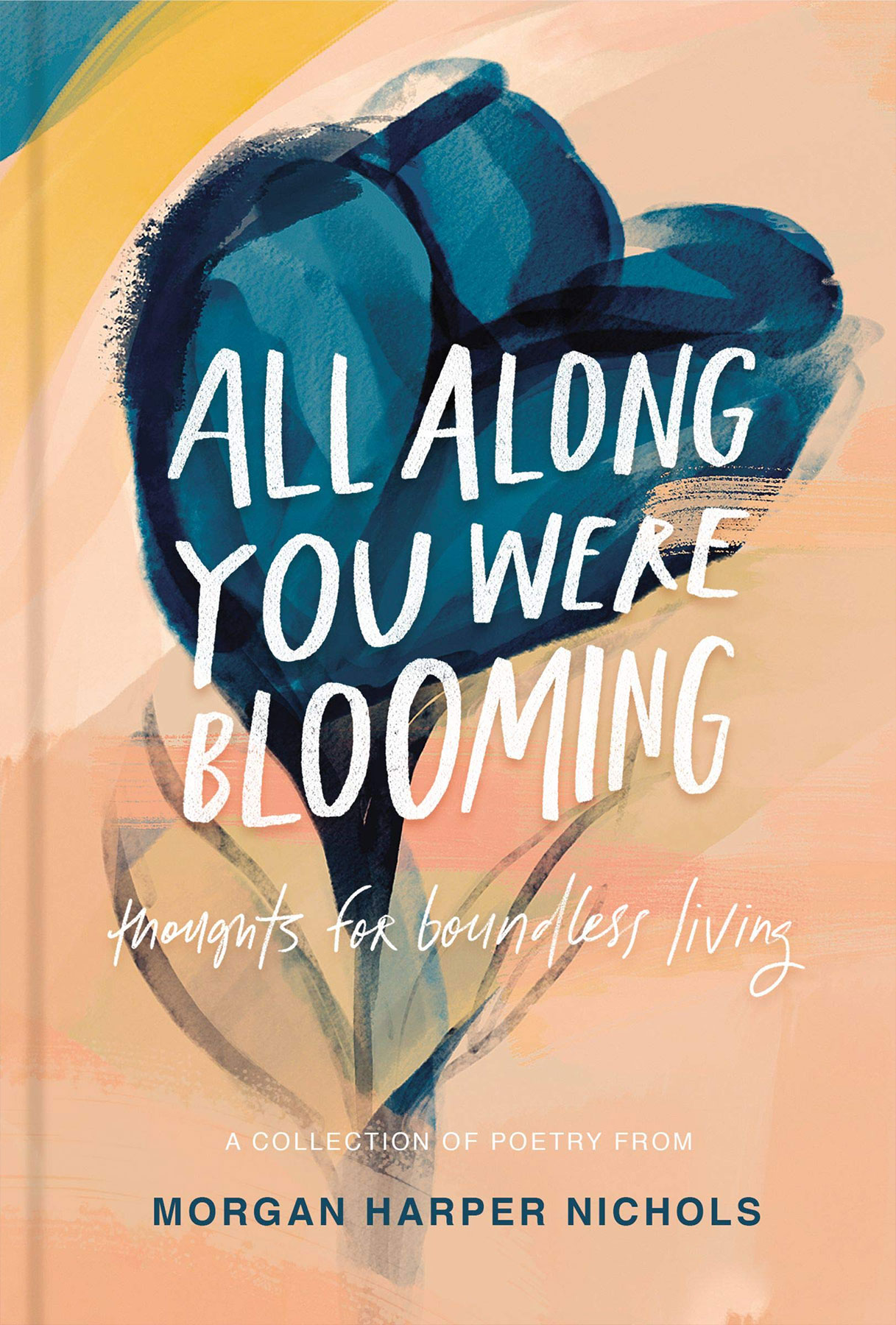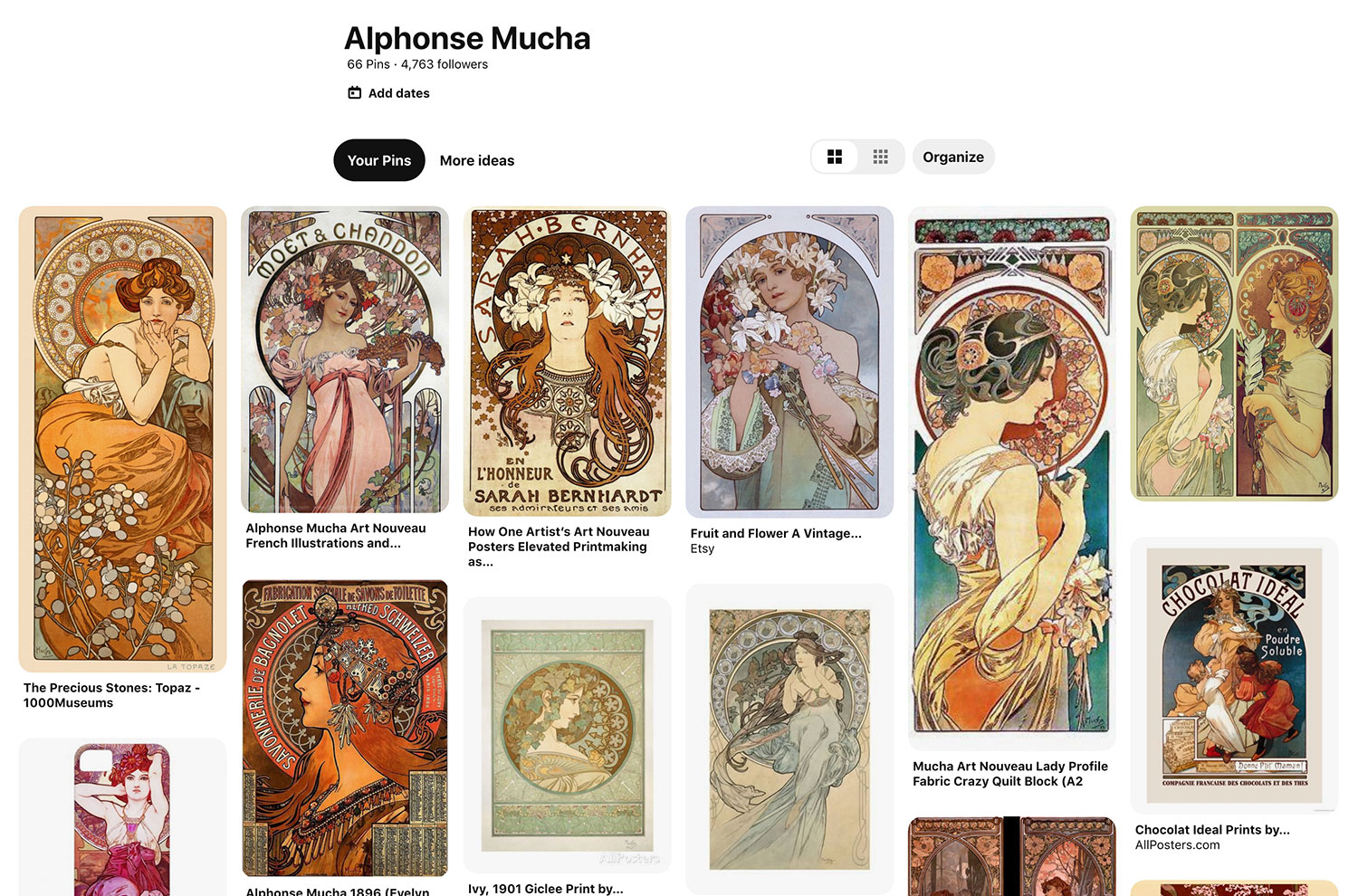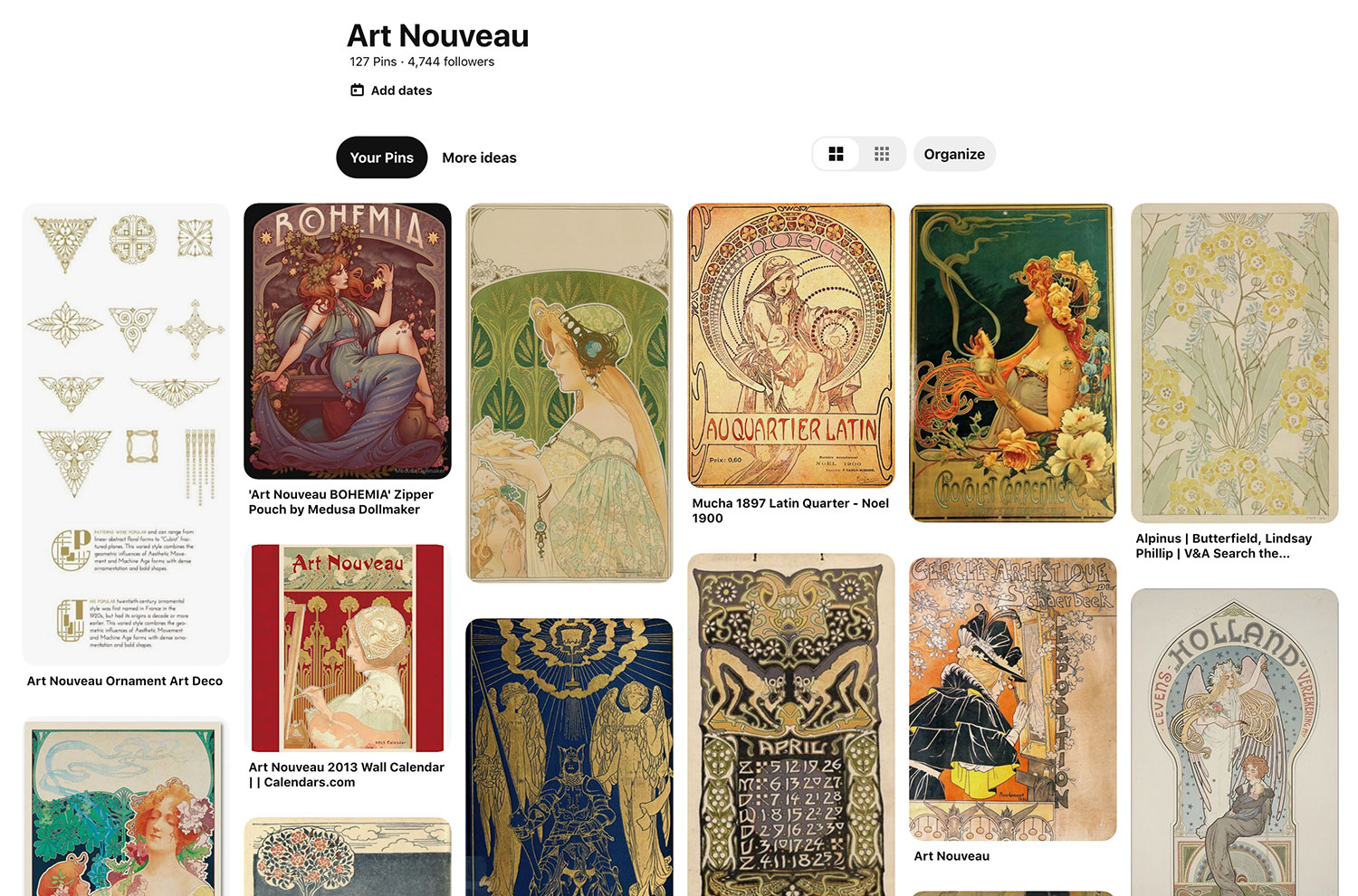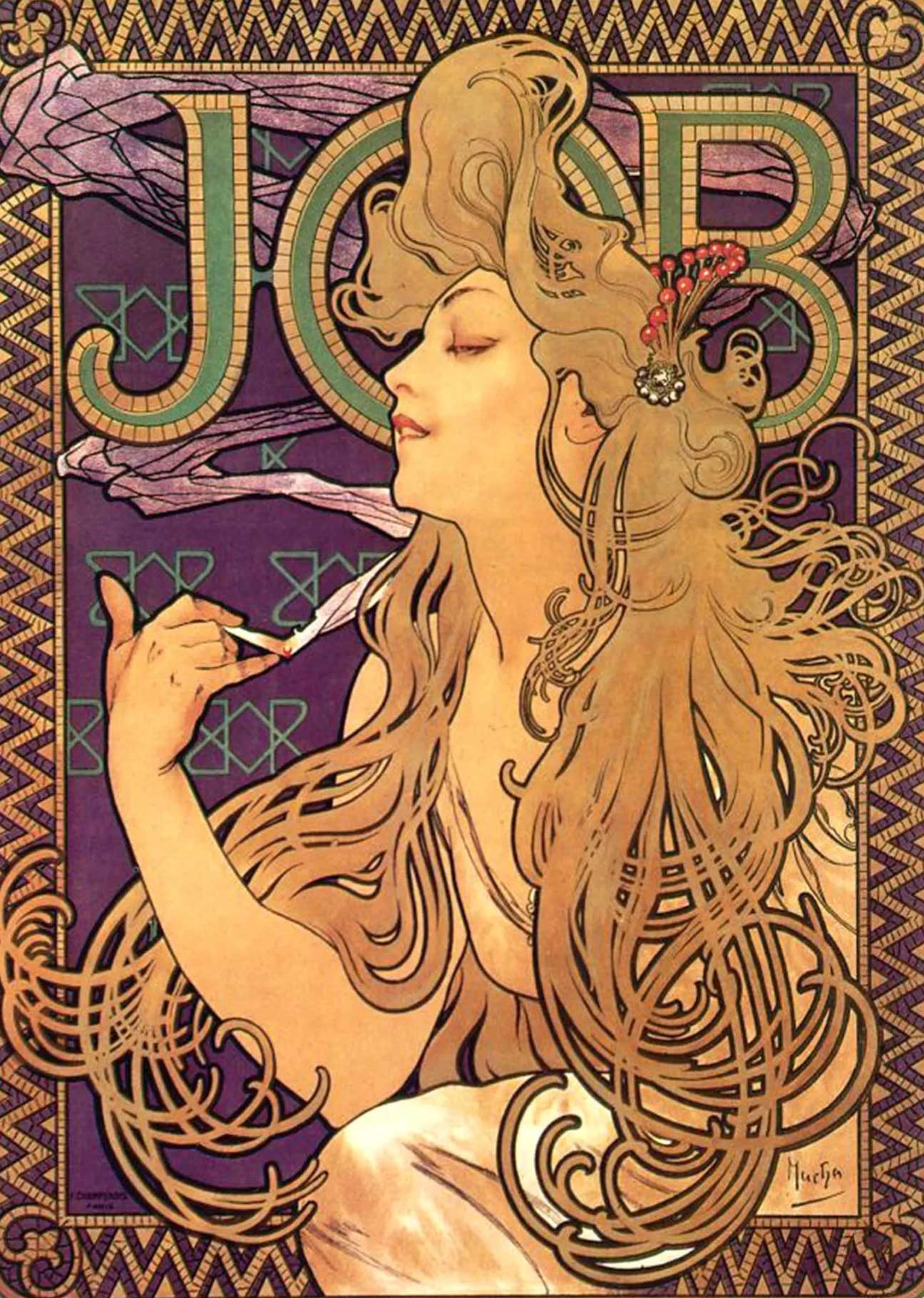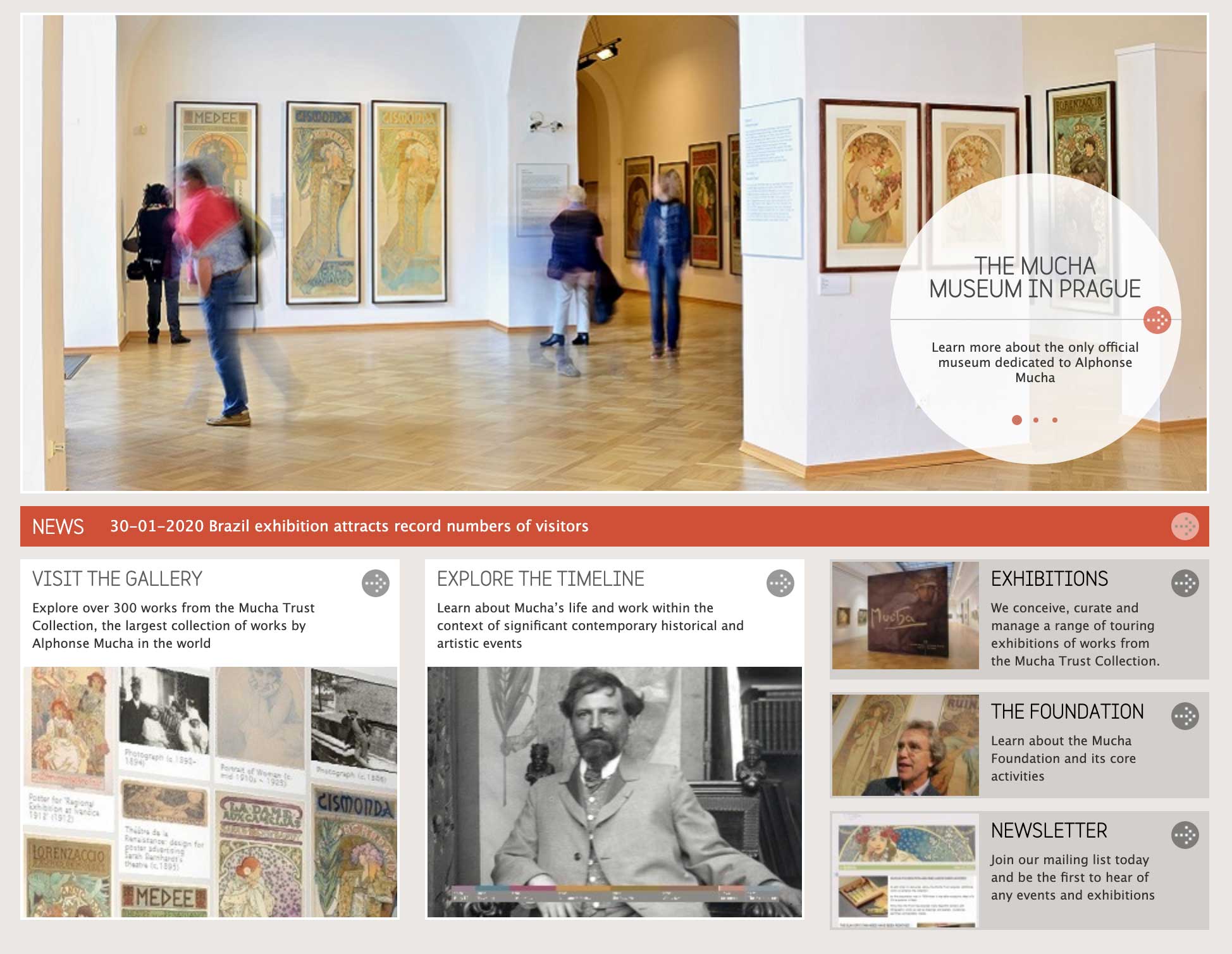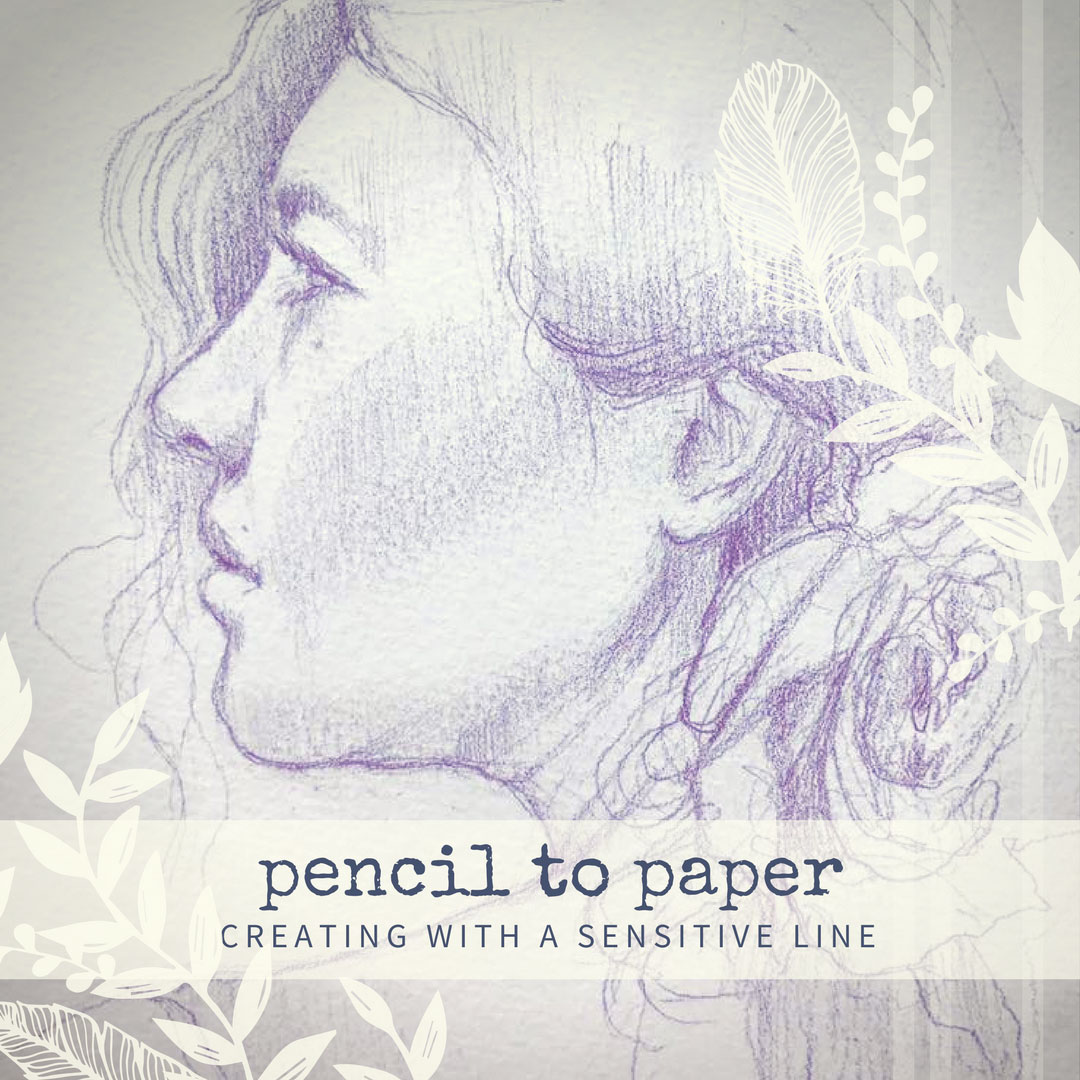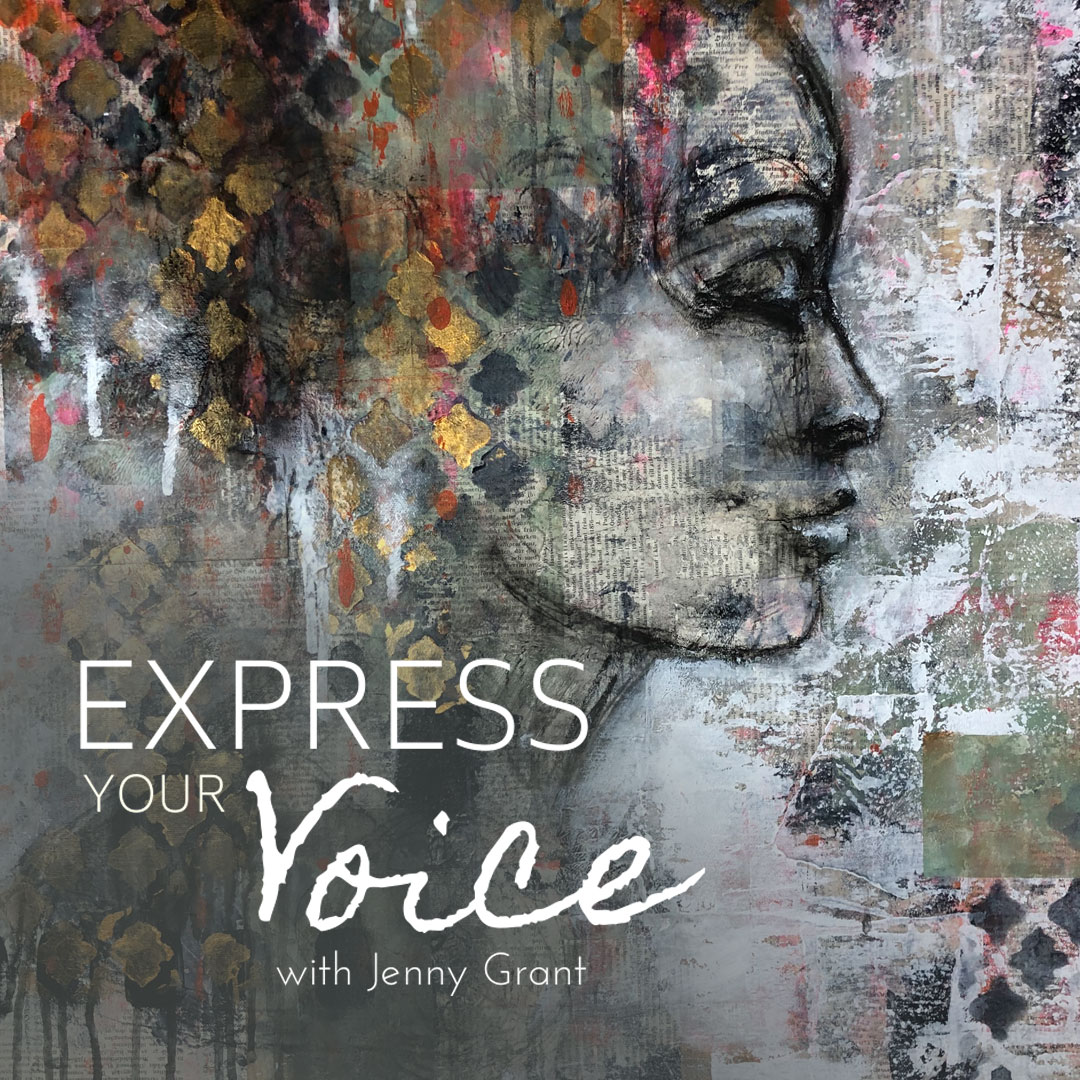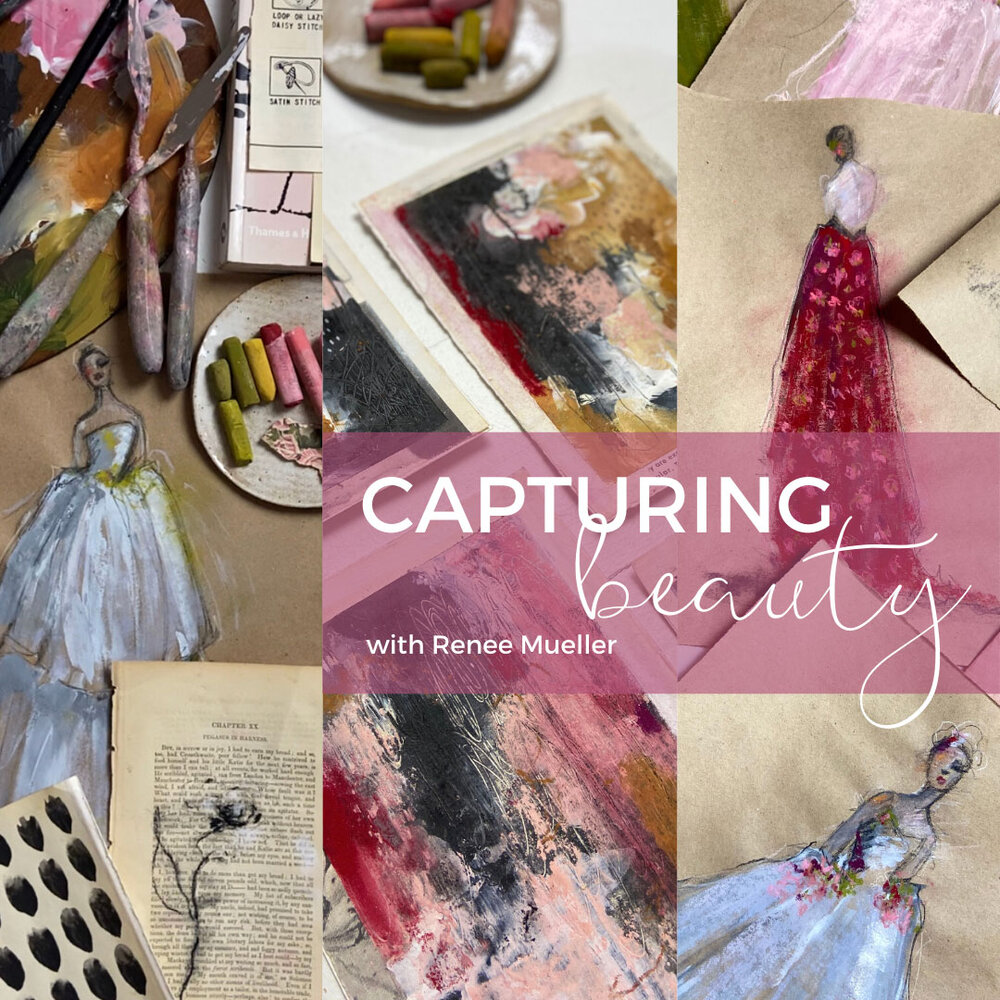IVY NEWPORT
Studioworks
Journal
a letter from ivy
Dear creative friends,
Welcome to Issue #17 of the StudioWorks Journal! As always, I’m super grateful you are here with me and I’m excited to share this with you. This month, I wanted to explore the theme of style and finding our creative voice.
This tends to be a compelling topic with artists and can often bring up questions and concerns about HOW exactly to discover our style or unique voice. So let’s journey on our creative path and unpack this topic together.
xo,

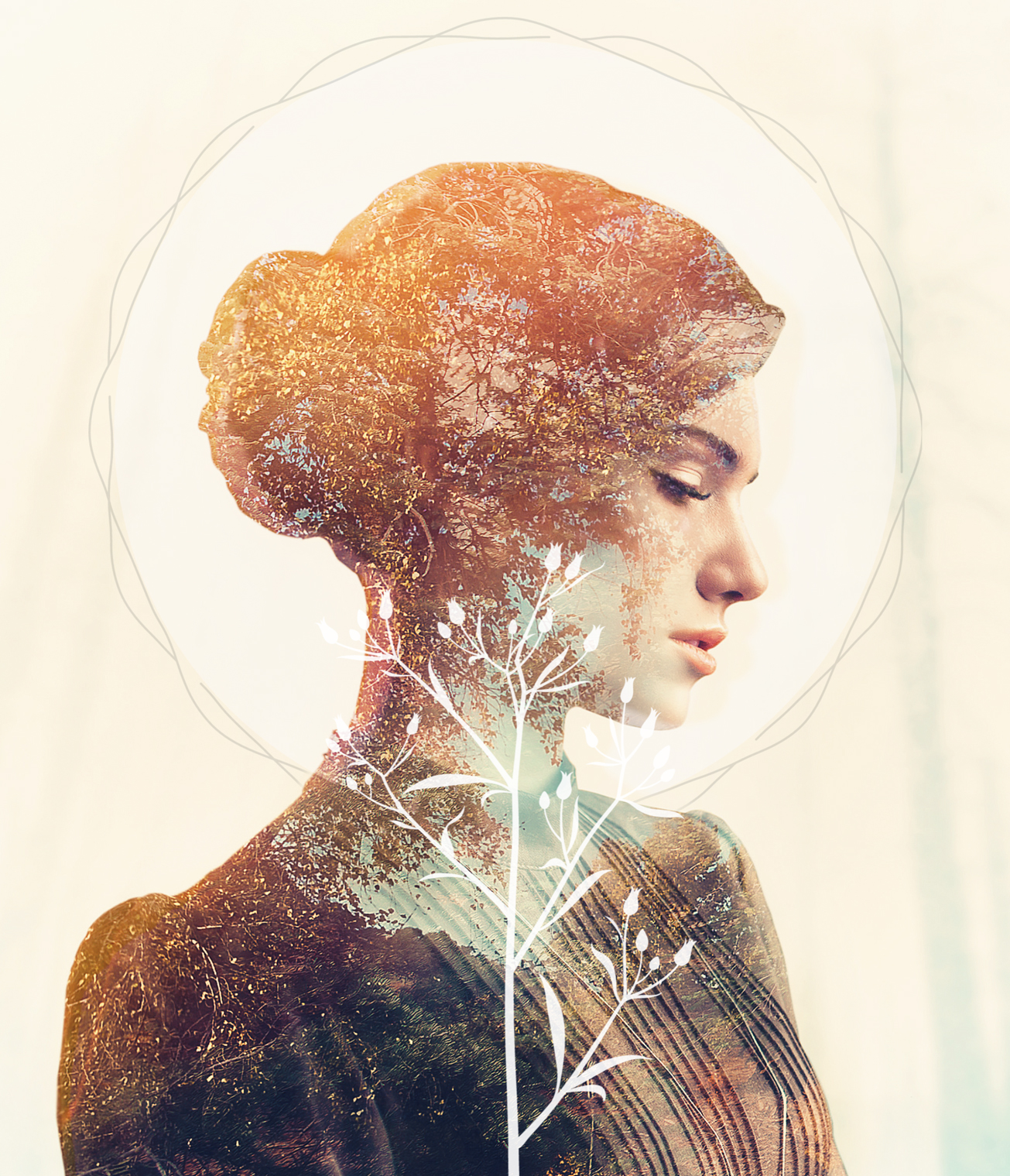
So you may be wondering, where do I start? To that, I say, wherever feels right to you. Each month we will have a theme, a creative affirmation, a power word, a color palette, sketchbook exercises, art projects, articles, recommended reading and access to wonderful inspiration and resources. I want you to think of this as a delicious new magazine, you know the ones you occasionally splurge on, with soft, velvety pages, beautiful images
Each issue will invite you to explore your creative practice in whichever way works for you. Experience each issue at your own pace. Take what resonates with you and put the rest aside for another time.
Grab a cup of something lovely and dive in.
MONTHLY THEME
Your Creative Style
“Style has no formula, but it has a secret key. It is the extension of your personality. The summation of this indefinable net of your feeling, knowledge and experience.”
– Ernst Haas
Ok…read that one more time. This wonderful quote by Ernst Haas, encapsulates my philosophy on style. So many of us, as we begin our creative journey, wonder “What is my style?” or “How do I get a style?” or we demand of our inner artists – “Figure out what my style is!” I have had artists convey to me a desperate need to seek this out, to discover the secret of style! I’ll share with you what I share with anyone who asks.
The secret to discovering your style is to discover yourself. Period.
Well…that sounds well and good but how the heck do we do that? I mean self discovery is a lifelong process right? Yup. It is. So we are discovering our style for our entire lives? Yup. Bingo. You see, in my opinion, style evolves as we evolve. Style unfolds and permeates our work as we unfold.
Let’s break this down a bit…
STYLE & INFLUENCE
Typically, you don’t start off with a distinctive style. You are new to creating. You are open. You are childlike and full of excitement, trepidation and awe at all the colors, paints, mediums, papers, markers, pens etc. Right? We all know this beautiful stage of initiation. You hoard art supplies, getting your hands on as much as you can. You start to take classes or obsessively watch YouTube videos. You watch eagerly as others create, observing their every move. You want the exact brush they use. You NEED the exact color blue. That special paper. You gather your supplies and your courage. You find your favorite artists and teachers. You obsessively create Pinterest boards or scroll through their Instagram feeds. You feel inspired! Lit from within at the possibility of creating your own artwork!
Finally you sit down, all your materials laid out like a surgeon. Your blank page stares back at you. You begin to make those first hesitant marks…you might be following along with a lesson or a book or just going for it, free form BUT you have been touched by your teachers or the artists you have admired. You most likely will see their influence in those first pieces. We learn by imitation. Just like a child will mimic the sounds you make to say their first words. As new artists, we copy. It’s just a fact. When the great artists of history were being trained they worked under other Masters and they often were tasked with creating studies. They would sit in the Louvre and paint for hours copying the Masters that came before them.
So, if you are feeling guilty or shameful about being so strongly influenced by your teachers and other artists – I tell you now – Don’t. Own your influences! When you create a study from one of your influencers, tell people who it is you are studying. Tag them if appropriate. Thank them for helping you learn. Know, that as you grow other art will influence you. Other artists will spark ideas within you. Art always comes from Art.
Eventually, as you discover more about how and why you create, your influencers will blend and meld with your own touch. Your style will bloom from the fertile ground of all you’ve learned from and all you’ve unearthed within yourself.
“Don’t just steal the style, steal the thinking behind the style. You don’t want to look like your heroes, you want to see like your heroes.”
– Austin Kleon
STYLE & EXPERIENCE
You want to find your style? Ok great…well, get ready to work your tail off. Style evolves as we show up and create consistently. As you learn techniques and enhance your skills you discover your relationship with different mediums. The way you apply the paint with your brush will be unlike anyone else. The way you interact with the clay before you will be your unique language of touch. Your pencil marks, clumsy at first, will become honed and natural with practice. With experience comes ease. With ease, more of yourself can spill into your work. With experience comes trust and confidence, cultivating these helps you express your truest self. Your truest self is your style.
Gaining artistic experience requires you to open your eyes. See the world through your artist’ eyes. It means seeing for the first time – color, light, form, emotion, beauty, pain. Art requires you to open your mind and your heart. It demands you to step into vulnerability. It insists on you looking within yourself and embracing ALL that resides there. Remember…your style is WHO you are. The answers are inside.
So show up and practice and toil if your truest desire is to make art. Push through the difficulty, the frustration, the fear, for on the other side of this is a world of color, expression, healing, joy and love. Art is worth every amount of struggle. Push on my friends. We are on this journey together.
“The circle of practice, fear, and showing up doesn’t go away with age, but it changes with experience”
– Lisa Congdon
STYLE & LOVE
Here’s the really yummy, juicy bit about the secret of style – Style comes from what you LOVE. Like what you really, really, really go nuts about. It could be the color blue. It could be squiggly lines made in ink. It could be your dog. It could be ALL these things and ten thousand other things. Your job is to discover WHAT and WHY you love the things you do. When we embrace what we adore we embrace ourselves. This inevitably comes out in our work.
For example, I really, really, really love nature’s beauty and female faces and forms and long, flowing hair and birds and feathers and flowers and nature and indigo blue and shimmering gold and strong lines paired with delicate lines and delicious layers of meaning and symbols and mythology and magic and the deep forests and mystery and smudgy undone bits, messy parts, emotional expressions and moody darkness paired with sparks of divine light…whew…I could go on…but I think you get the picture.
So, what was that all about? Well, I just described almost all of the elements of my artistic style. Huh…that was fun.
By simply allowing myself to shine light on all that I adore I can get some VERY important clues about what my artwork or artistic style is going to reflect.
You’re going to get a chance to do just that in our Writing Prompt later in the journal! Have fun with it and watch for those clues! You actually know more about your style than you think.
“Style essentially appeared out of what I liked to do.”
– Robert Genn
The Quintessence
INFLUENCE + EXPERIENCE + PASSION = STYLE
When we combine our influences, our experience and our passion we excavate our creative style. We discover that our style emerges as a distillation of these multiple aspects. In the ancient art of alchemy, different elements were combined to create the quintessence. (God I love that word.) This was defined as “the essence of a thing in its purest and most concentrated form.”
The quintessence is your style! It is your breath that breathes life into your art. It is the fifth element! Essential, primal and absolutely magical. It is the core essence of WHO YOU ARE. Isn’t that so exciting!?
“You are your style. Inseparable, one and the same, no matter what you choose to create.”
– Sonja Donnelly
STYLE & FLOW
It’s important to note that our Style is not a fixed thing…it flows and evolves as we do. You might even form multiple styles. That’s ok too. Your essence will still be present in each.
Don’t create a self imposed prison of style. Don’t box yourself in. You are allowed to change – you will whether you like it or not! You cannot imagine that a stone in the river won’t be shaped by the water. You are the same. Life will flow around you and you will be changed by it, allow this to be reflected in your style. You are allowed to pivot. You are allowed to be inspired by new influences. To learn new techniques. To try new things! You are allowed to choose. Don’t let your style dictate who you are but rather the reverse. You determine the way you express yourself. No exceptions. No excuses. No apologies.
Now go learn, go practice, do the hard work, open your eyes and embrace what you love. Let your style emerge as you turn yourself inside out. Let the truth and beauty of who are shine through and hold onto it ALL with fierce acceptance and deep compassion. Art will teach you how to love yourself, if you let it.
“There’s no rule to say you must use only one style. It’s entirely up to you. You’re the artist, you’re the boss, it’s your painting. ”
– Marion Boddy-Evans
Your Creative Style
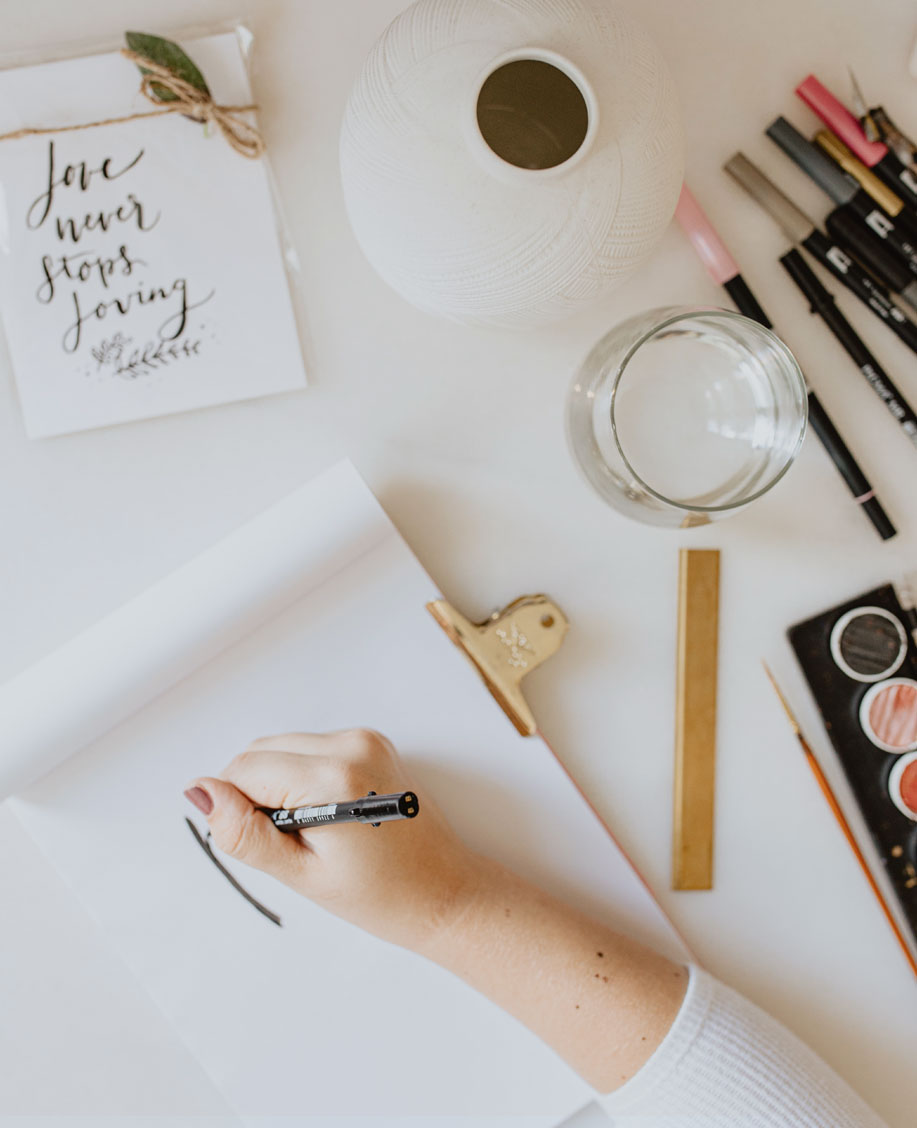
STYLE SEEKER PROMPT:
- LOVE LETTER – Write yourself a love letter. In it, list all the things you love in this world and express how you want to weave this into your artwork. Be compassionate and kind. Send your inner artist messages of acceptance and joy.
“Inspiration doesn’t follow style, it creates it.”
― Darby Bannard
join us in the
Studioworks
creative academy
SAVE UP TO 40% OFF – LIMITED TIME OFFER
Did you know your Studioworks membership unlocks full access to over 180+ CREATIVE CLASSES? No more waitlists or wishing you could join a class.
In addition, you will receive a monthly issue of the STUDIOWORKS JOURNAL. Here you’ll find articles, creative prompts, curated resources, downloadable artistic affirmations, sketchbook explorations, a full-length art lesson AND MORE!
WORD OF THE MONTH
Style
A manner of doing something. (noun)
Design or make in a particular form. (verb)
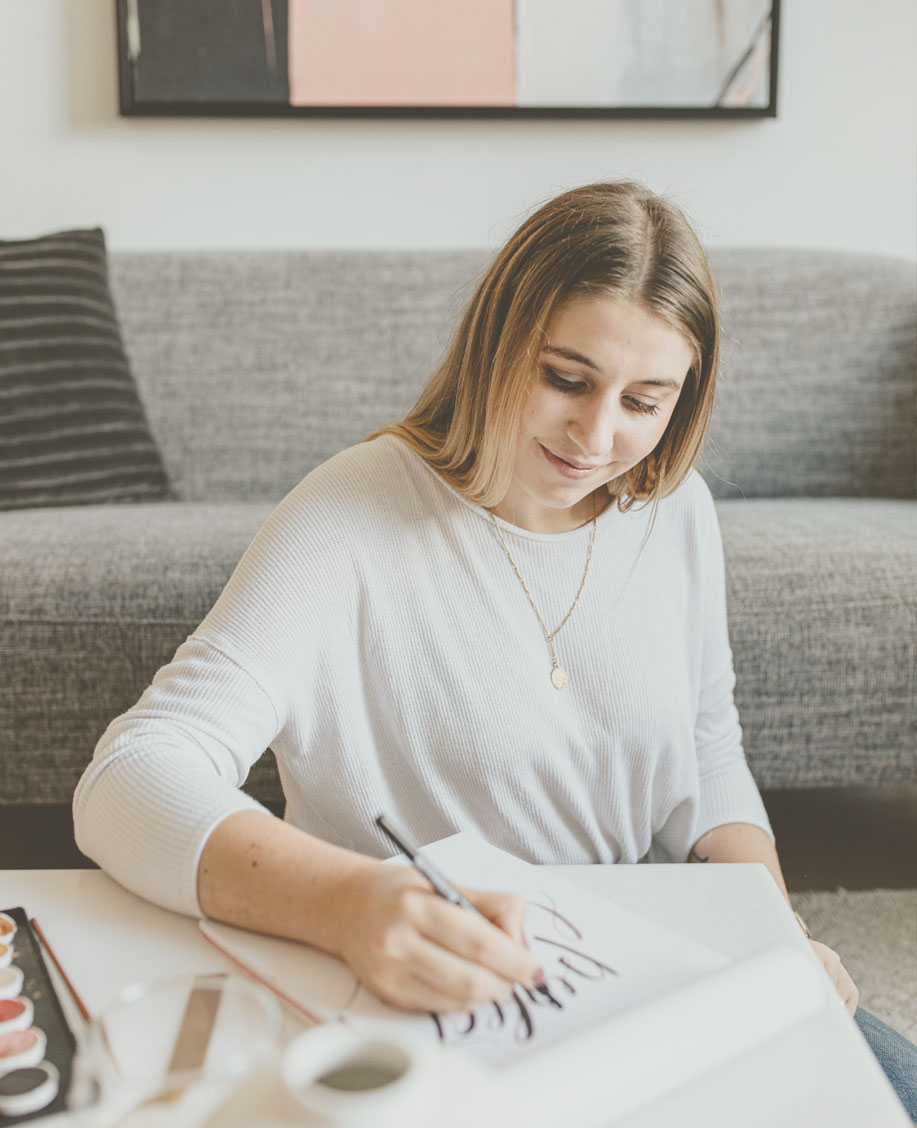
As artists, our style can become of paramount importance, often leading to a feeling of lack or confusion. But when I define this word relating to art, it is the essence of who we are. It is our creative fingerprint and our unique signature. This signature is informed by our influences, our experiences and our passions.
“We don’t need to impose a style, we just have to show up and be present to catch its unfolding.”
– Linda Saccoccio
WRITING PROMPT:
- Try this!! Create your own list of LOVE! Write a VERY run-on sentence in your art journals. Write down everything you LOVE. What comes up? Are you seeing these things reflected in your art? If not, why? If so….do more!Creativity runs on joy. So run with joy like a wild horse along the shore! Your style will emanate from your art like ripples in the tide.The next bit is to figure out WHY you love these things. This is the unfolding of your creative voice.
For me, I love the things I love because I am fascinated by the unknown aspects of our world, the secrets, the hidden magic. I wonder about our connection to nature, to the divine to each other. Faces, to me, are portals of connection. Expression is the universal human link – we recognize pain, we know joy, we understand sadness…I want my paintings to evoke emotion. I want people to witness their own divinity in my work. I want my work to show the liminal space between what we know and what we don’t. I want my art to illuminate the darker corners. I want my art to impart beauty and mystery in equal measure. I want my art to breathe life into a singular moment. A second of recognition. A sparkling acknowledgement of the magnificence that is being alive.
Okay…your turn. Don’t judge what comes out. Write from your heart. What do you WANT from your art? Feel into the words. There is NO wrong answer. Your creative voice has a unique message for you and the world. It is vital and worthy. Let the bird within you sing.
Pairing your creative voice with your creative style equals authentic expression and the creation of your most rewarding work.
Word of the Month : Style
Your Creative Power Meditation
Your creative power is within you at your core. This space is often referred to as your solar plexus chakra. It is the place where you feel your power and intuition. Let’s focus on harnessing the power of this fierce place and use its ability to burn away fear, doubt or judgement that might be blocking your creativity.
This gorgeous meditation is by one of my favorite teachers – Rachel Hilary. Her melodic voice and enchanting words will soothe your soul and take you on a mystical journey
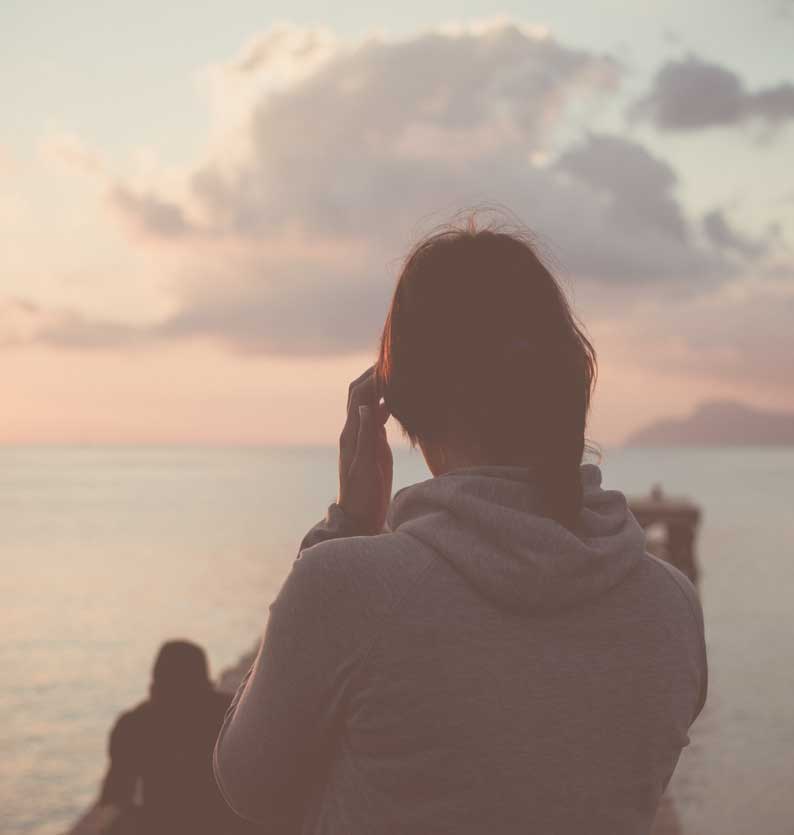
“As you grow older, it dawns on you that you are yourself – that your job is not to force yourself into a style but to do what you want.”
― Beth van Hoesen
Your Creative Power Meditation
Creating a body of Work
As we approach a more solid understanding of our own style we may feel drawn to the idea of creating a “body of work”. This is a natural progression and one that can further our style’s strength and illuminate its more subtle characteristics.
In the past, I have worked with a few students to help facilitate this process and I wanted to share these actionable steps with you.
Get a dedicated journal or sketchbook for this process.
1. Print out the pieces of art you created recently (in the last 6-12 months that brought you the MOST joy)
2. Identify and write down what about these pieces made you so happy… e.g. the realism, or lack of, the color palette, the style, the techniques. Write down five things for each piece.
3. Now see if there is a pattern or connection here….are they mostly realistic or are they mostly florals? etc…
4. Write down the unifying aspects…..e.g. Limited Color palette, florals, realistic (try and find 3-4 unifying aspects)
5. Commit to creating a series with these aspects. Make your series say 4-10 pieces…you can vary the size and even the medium somewhat but stay within the core aspects you defined. Write down a DEADLINE for when the pieces need to be done then stick to it.
6. CREATE your series!!! Focus only on the series while you are creating it. Don’t do other lessons or projects during this time. Limit your time online looking at other people’s art. You need time to spend alone and without interference or noise (social media) Don’t post the pieces online until you have completed the series, this is not the time for validation or seeking approval, this will only confuse you. This is a time to honor your individual process.
7. When you are done. Lay the pieces out before you. Get that journal out ready to make some notes. Notice which piece is your favorite or which is the strongest. Why? Which feels the weakest. Why? What piece did you love creating the most. Why? Which challenged you or brought up frustration or blockage? Why? How was the overall experience of creating a series? What have you learned from the process? What will you do differently next time?
What worked well for you?
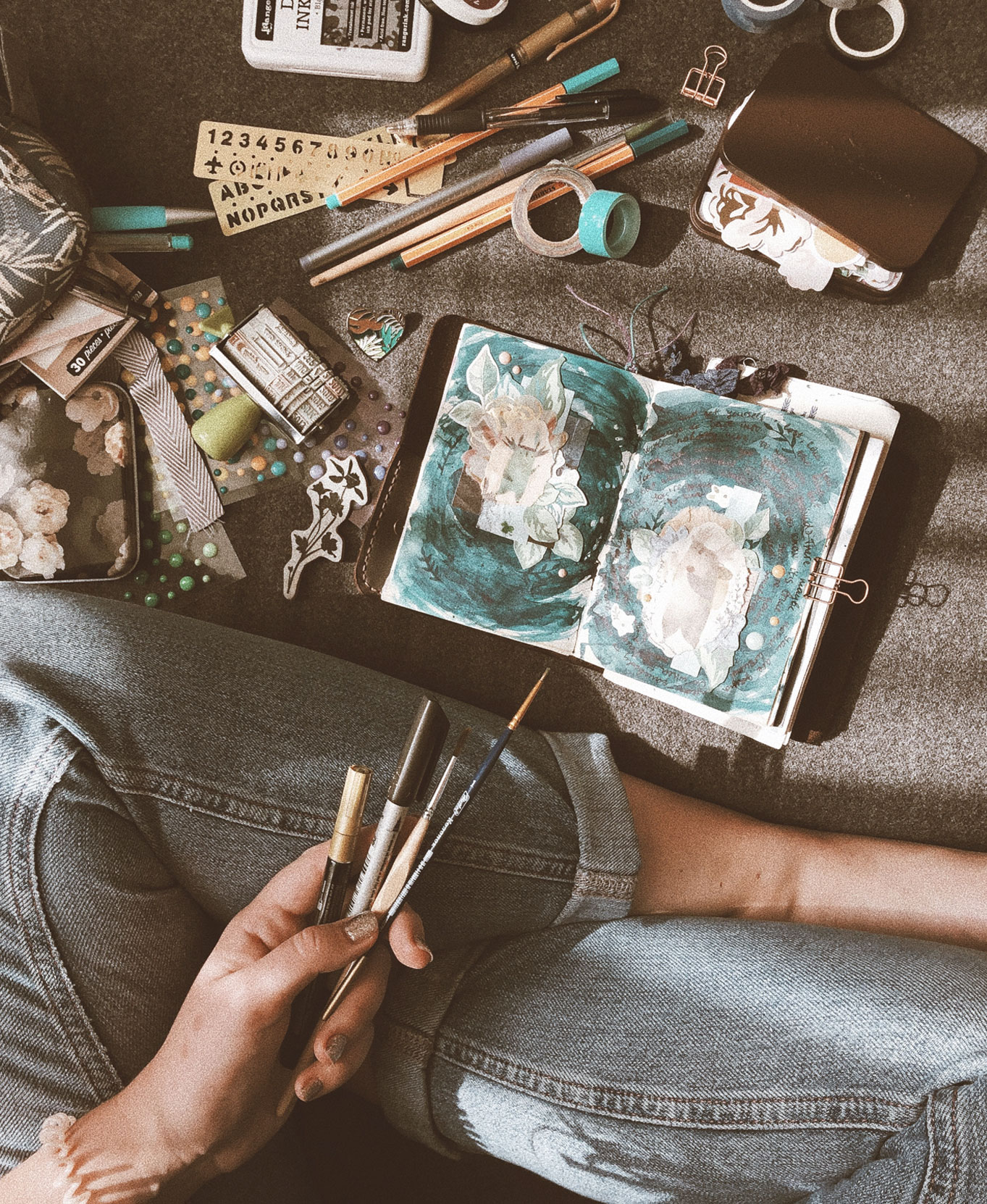
Documenting the experience will provide you with vital information about how you processed this project and how to proceed. Maybe you feel inclined to do another body of work or maybe you need a break and you want to explore and experiment with new ideas. Honor what feels right. You may also feel rather uninspired and need a creative break. That is perfectly normal after such an outpouring of creativity. Listen to what your mind, heart and body need to refuel.
If you feel like sharing within our community about your experience creating a body of work in this way please do! We would love to hear about it!
ENJOY the ride! You will face challenges, setbacks and plenty of self doubt but move forward towards your goal and keep your eye on that deadline. When you emerge from this process, you will have grown creatively and will have a deeper connection with how and why you express yourself.
Creating a body of Work
Monthly Affirmation
Each month we will have a positive affirmation. I recommend you print out this affirmation and put it in your sketchbook or somewhere in your studio. Recite the affirmation out loud each time you show up to create. Saying words aloud is powerful and can begin to re-write some of our own limiting beliefs or calm our fears. Try it now…
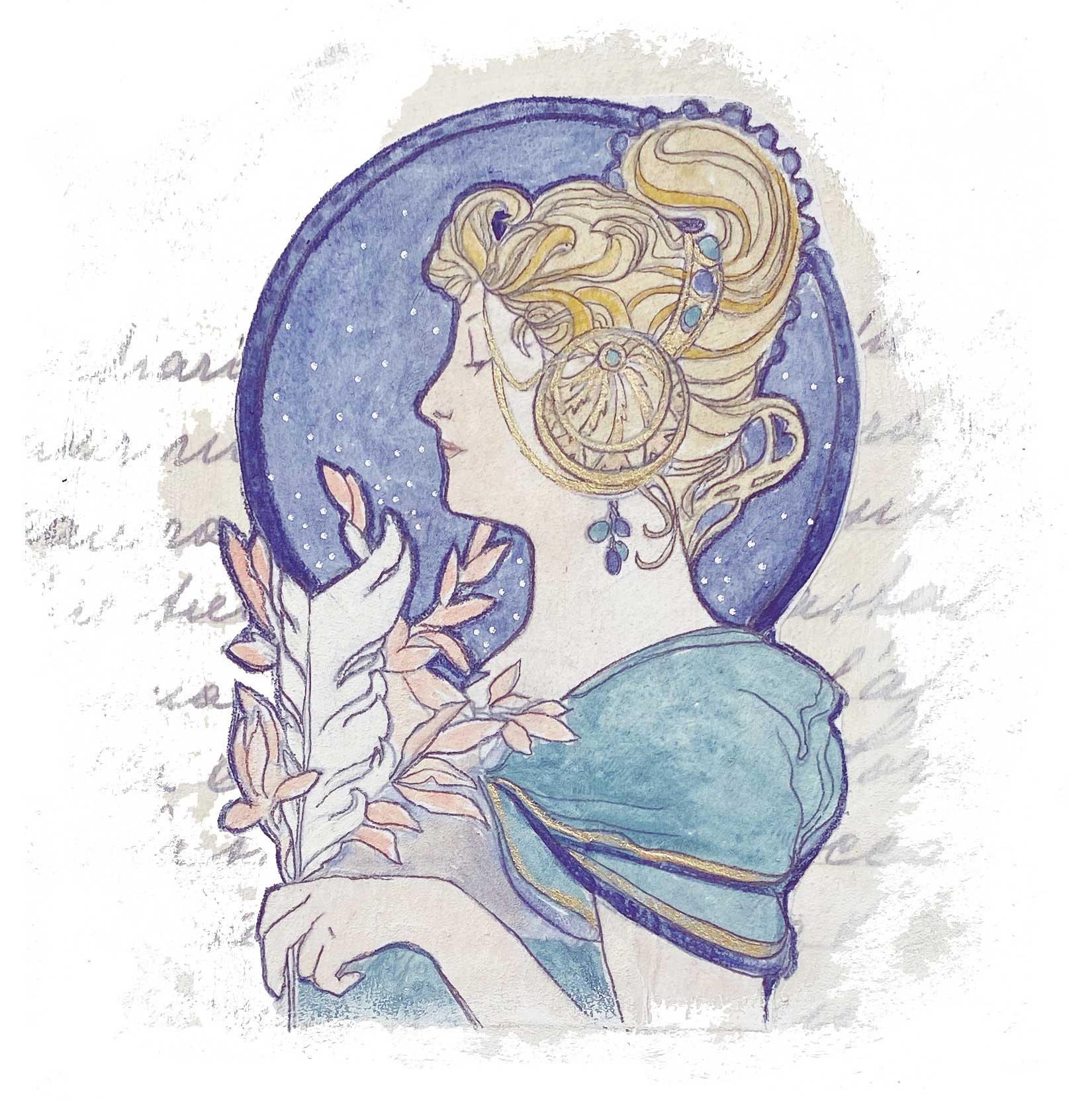
Color Palette of the Month
This month, as we focus on our creative style…well, I can only share my own. And I can only reflect upon what has shaped my style. It’s been many things but one of my first influences was the Art Nouveau movement and especially the work of Alphonse Mucha. So, I have selected what I feel to be, an art nouveau color palette. It is an array of dusty pink, soft peach, vintage parchment, aged gold, muted teal and deep velvet blue. You see these tones in much of Mucha’s work and I, in turn, see them in my own work as well. This is no mistake…but an example of how his influence has affected my creative expression.
Now, since we are discussing personal style, this month I highly recommend that you create a color palette that truly calls to you! Look around at the artists you love, the things in your home, the clothes that you wear. What colors make you happy and bring you joy? What colors do you want to use the MOST in your work right now? Use those colors! Explore them and celebrate what they mean to you.
Color Palette

“Beauty begins the moment you choose to be yourself.”
– Coco Chanel
Color Palette
STYLE SEEKER PROMPT:
- STYLE COLLAGE – go through some old catalogues and magazines. Pull out anything, ANYTHING that speaks to you. Even if you don’t know why. It could be a person, a color, an item, a scene, a pattern. Once you are done, sift through them. What pulls at you the most. Make a pile of those. Put aside the rest. Create a fun collage incorporating all the elements. Make note of why you selected them. The more you know yourself, the more you’ll know your style.
MASTER ARTIST GUIDE
Alphonse Mucha
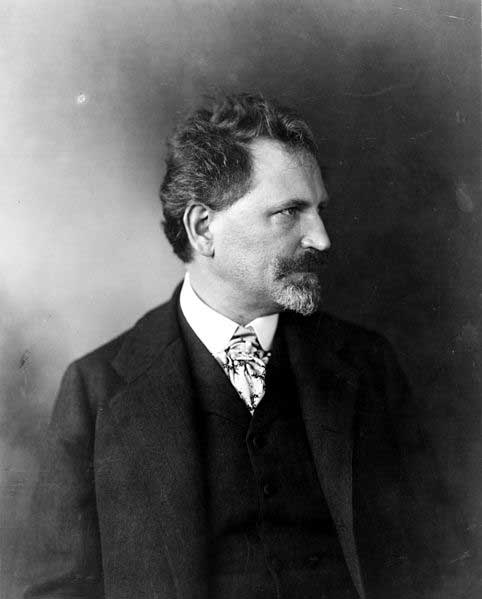
As previously mentioned, one of my most potent influencers is Alphonse Mucha – the father of the Art Nouveau movement. Although it may not be apparent in all my works, I can usually see a glimmer of connection to this artist and this style.
The soft colors, the muted tones, the feminine grace and lyrical line work, the connection to natural forms like leaves and flowers, the symbolism and mythology that was often seen in Art Nouveau works – ALL of these things are important to me and what I create. So when faced with selecting a Master Artist for the month, I could not look past Mucha.
Upon doing further research, I was especially touched by the way Christian Brinton, an art historian described the works of Mucha –
“His art is a sumptuous art, floral, astral, feminine; it reflects with tender nonchalance the fluid beauty of form and the delicately veiled secrets of the soul.”
I’m not sure I could resonate more with such a statement. Furthermore, read how Mucha, himself describes the wants of his own work…
“The purpose of my work was never to destroy but always to create, to construct bridges, because we must live in the hope that humankind will draw together and that the better we understand each other the easier this will become.”
And this…
“Art exists only to communicate a spiritual message.”
To be honest, this is the first time I have read these quotes and in this very moment, I am in awe with how connected I feel to this way of thinking. How it sounds familiar in my own ears and rings so true in my heart.*
*Sidenote – I love that I get these “aha” moments when I write for you all. So grateful.
Okay, while I recover from my awe struct wonder — let’s learn a little more about this artist –
Let’s learn a little more about this artist
Alphonse Maria Mucha was born in the town of Ivancice, Moravia (today’s region of Czech Republic). His singing abilities allowed him to continue his education through high school in the Moravian capital of Brünn, even though drawing had been his first love since childhood. He worked at decorative painting jobs in Moravia, mostly painting theatrical scenery, then in 1879 moved to Vienna to work for a leading Viennese theatrical design company, while informally furthering his artistic education.
In 1881, he returned to Moravia, doing freelance decorative and portrait painting. Count Karl Khuen of Mikulov hired Mucha to decorate Hrusovany Emmahof Castle with murals, and was impressed enough that he agreed to sponsor Mucha’s formal training at the Munich Academy of Fine Arts.
Mucha moved to Paris in 1887, and continued his studies at Académie Julian and Académie Colarossi while also producing magazine and advertising illustrations. Around Christmas 1894, Mucha happened to drop into a print shop where there was a sudden and unexpected demand for a new poster to advertise a play starring Sarah Bernhardt, the most famous actress in Paris, at the Théatre de la Renaissance on the Boulevard Saint-Martin. Mucha volunteered to produce a lithographed poster within two weeks, and on 1 January 1895, the advertisement for the play Gismonda by Victorien Sardou appeared on the streets of the city. It was an overnight sensation and announced the new artistic style and its creator to the citizens of Paris. Bernhardt was so satisfied with the success of that first poster that she entered into a 6 years contract with Mucha.
Mucha produced a flurry of paintings, posters, advertisements, and book illustrations, as well as designs for jewellery, carpets, wallpaper, and theatre sets in what was initially called the Mucha Style but became known as Art Nouveau (French for ‘new art’). Mucha’s works frequently featured beautiful healthy young women in flowing vaguely Neoclassical looking robes, often surrounded by lush flowers which sometimes formed haloes behind the women’s heads. In contrast with contemporary poster makers he used paler pastel colors.
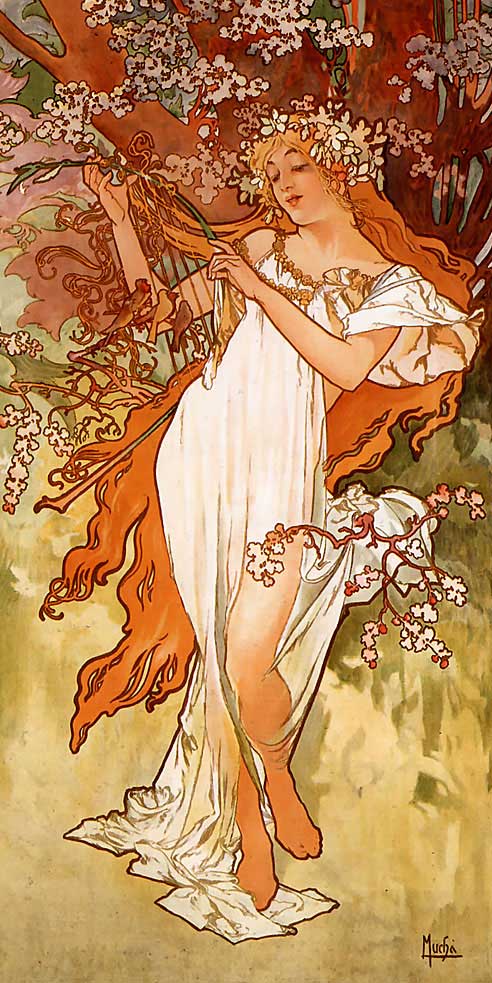
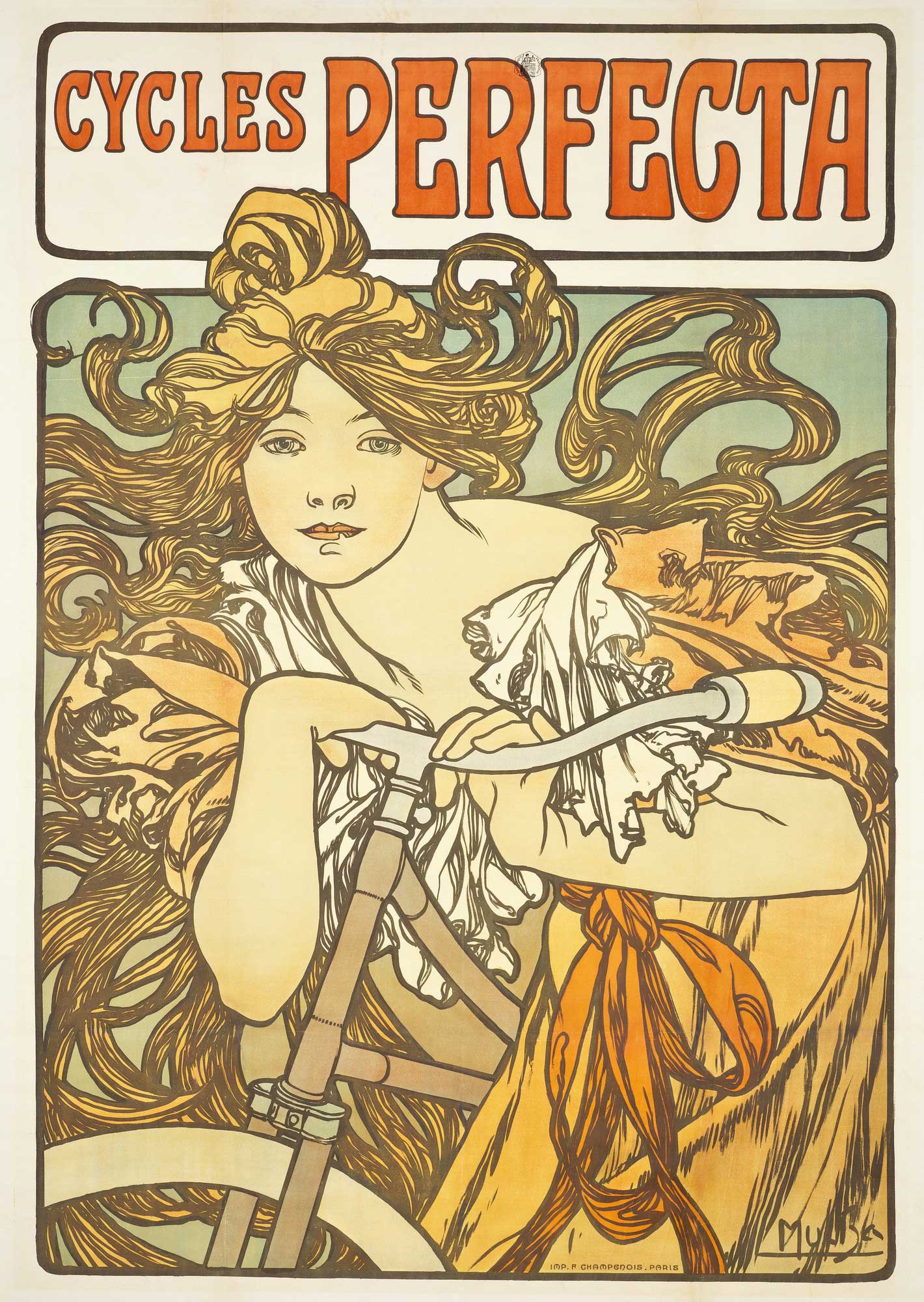
His Art Nouveau style was often imitated. However, this was a style that Mucha attempted to distance himself from throughout his life; he insisted always that, rather than adhering to any fashionable stylistic form, his paintings came purely from within.
He spent many years working on what he considered his fine art masterpiece, The Slav Epic, a series of twenty huge paintings depicting the history of the Czech and the Slavic peoples in general, bestowed to the city of Prague in 1928. He had dreamt of completing a series such as this, a celebration of Slavic history, since he was young. Since 1963 the series has been on display in the chateau at Moravsky Krumlovat the South Moravian Region in the Czech Republic.
The rising tide of fascism in the late 1930s led to Mucha’s works, as well as his Slavic nationalism, being denounced in the press as ‘reactionary’. When German troops marched into Czechoslovakia in the spring of 1939, Mucha was among the first people to be arrested by the Gestapo. During the course of the interrogation the aging artist fell ill with pneumonia. Though eventually released, he never recovered from the strain of this event, or seeing his home invaded and overcome. He died in Prague on July 14, 1939 of a lung infection, and was interred there in the Vyšehrad cemetery.
Enjoy this slide show of his work
“What is it, Art Nouveau?… Art can never be new.”
― Alphonse Mucha
Learn more about Alphonse Mucha’s life below…
Here’s a Pinterest board full of his work to inspire you!
Master Artist Guide
join us in the
Studioworks
creative academy
SAVE UP TO 40% OFF – LIMITED TIME OFFER
Find creativity that fits your goals, mood and experience level anytime! With over 180 CREATIVE CLASSES, meditations, creative journals and more, you’re sure to find the right class at just the right moment.
Inside Studioworks, there’s an amazing creative community waiting to guide and support you along your creative journey!
Art Nouveau Style
Since our Master artist is Alphonse Mucha, I wanted to include a little more about the Art Nouveau movement and style characteristics –
Art Nouveau is an international style of art, architecture and applied art. The style was most popular between 1890 and 1910. It was a reaction against the academic art and eclecticism of 19th century architecture and decoration. It was often inspired by natural forms such as the sinuous curves of plants and flowers. Other characteristics of Art Nouveau were a sense of dynamic movement, often expressed with asymmetry or whiplash like lines.
One major objective of Art Nouveau was to break down the traditional distinction between fine arts (especially painting and sculpture) and applied arts. It was most widely used in interior design, graphic arts, furniture, glass art, textiles, ceramics, jewelry and metal work.
As an art style, Art Nouveau has affinities with the Pre-Raphaelites and the Symbolist styles, and artists like Aubrey Beardsley, Alphonse Mucha, Edward Burne-Jones, Gustav Klimt and Jan Toorop could be classed in more than one of these styles. Unlike Symbolist painting, however, Art Nouveau has a distinctive appearance; and, unlike the artisan-oriented Arts and Crafts movement, Art Nouveau artists readily used new materials, machined surfaces, and abstraction in the service of pure design.
The graphic arts flourished in the Art Nouveau period, thanks to new technologies of printing, particularly colour lithography, which allowed the mass production of colour posters. Art was no longer confined to galleries, museums and salons; it could be found on Paris walls, and in illustrated art magazines, which circulated throughout Europe and to the United States. The most popular theme of Art Nouveau posters was women; women symbolizing glamour, modernity and beauty, often surrounded by flowers.
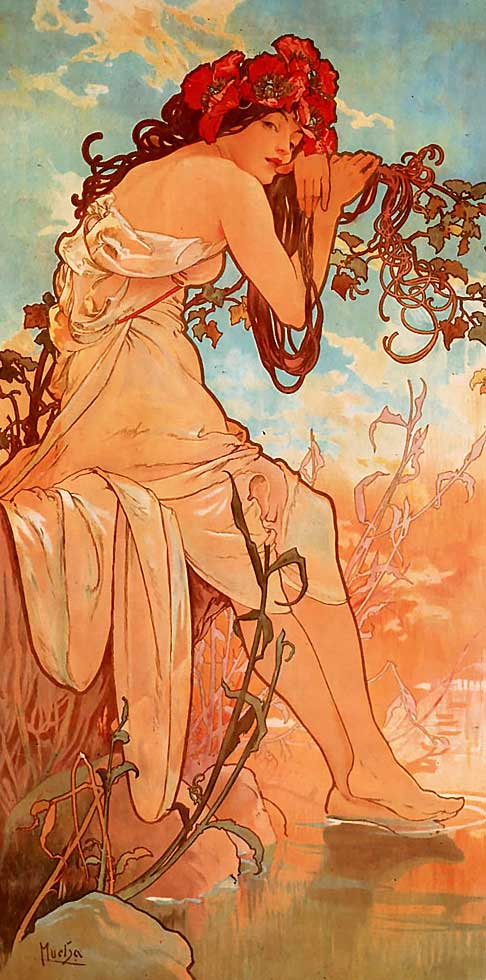
Key stylistic features –
- Curvilinear lines
- Elements of nature often floral
- Feminine figure or figures
- Flowing movement
- Varied line weights (from thin to thick)
- Attention to detail
- Intertwining forms
- Soft colors
10 Art Nouveau artists to explore
- Aubrey Beardsley
- Eugène Grasset
- Koloman Moser
- Gustav Klimt
- Jessie M. King
- Walter Crane
- Jules Chéret
- Henri Privat-Livemont
- Paul Berthon
- Jan Toorop
Art Nouveau Style
Sketchbook Explorations
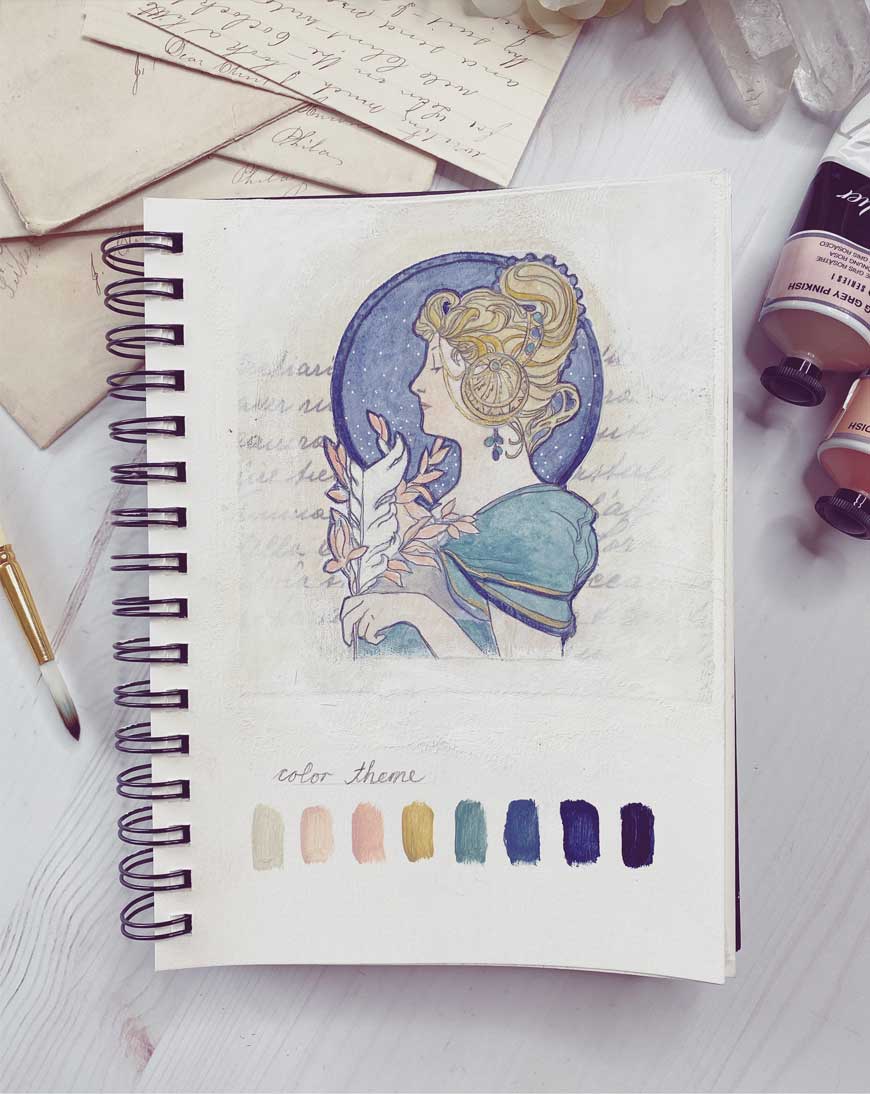
Before we begin our explorations, I wanted to provide a cohesive theme for us to focus on. This will help unify our explorations and provides us with a simple place to start when approaching a VERY blank sketchbook.
Our sketchbook theme this month is discovering style within ourselves. So we will focus on some explorations to do just that. While you are welcome to be inspired by the Art Nouveau movement and Alphonse Mucha if this calls to you, I also encourage you to become more aware of your own influences and dive deeper into them.
Please remember, our explorations in our sketchbook are really just access points to get you into the flow. However, they can also be seeds for new ideas, concepts and themes in your art. Some of them will be more about writing and others more about drawing and painting. You will see below three prompts and exercises explained and photographed from my own sketchbook. You are welcome to expand upon, invent and experiment with your own concepts too. Use our color palette if you want to. You will see I stay in that theme for my explorations. These may feel silly at first but let your inner artist play.
EXPLORATION 1
Art Nouveau Moment
Create a page dedicated to the Art Nouveau movement. You can draw, paint, or collage. Explore the beautiful aspects of this art style and see what it feels like to create with its influence.
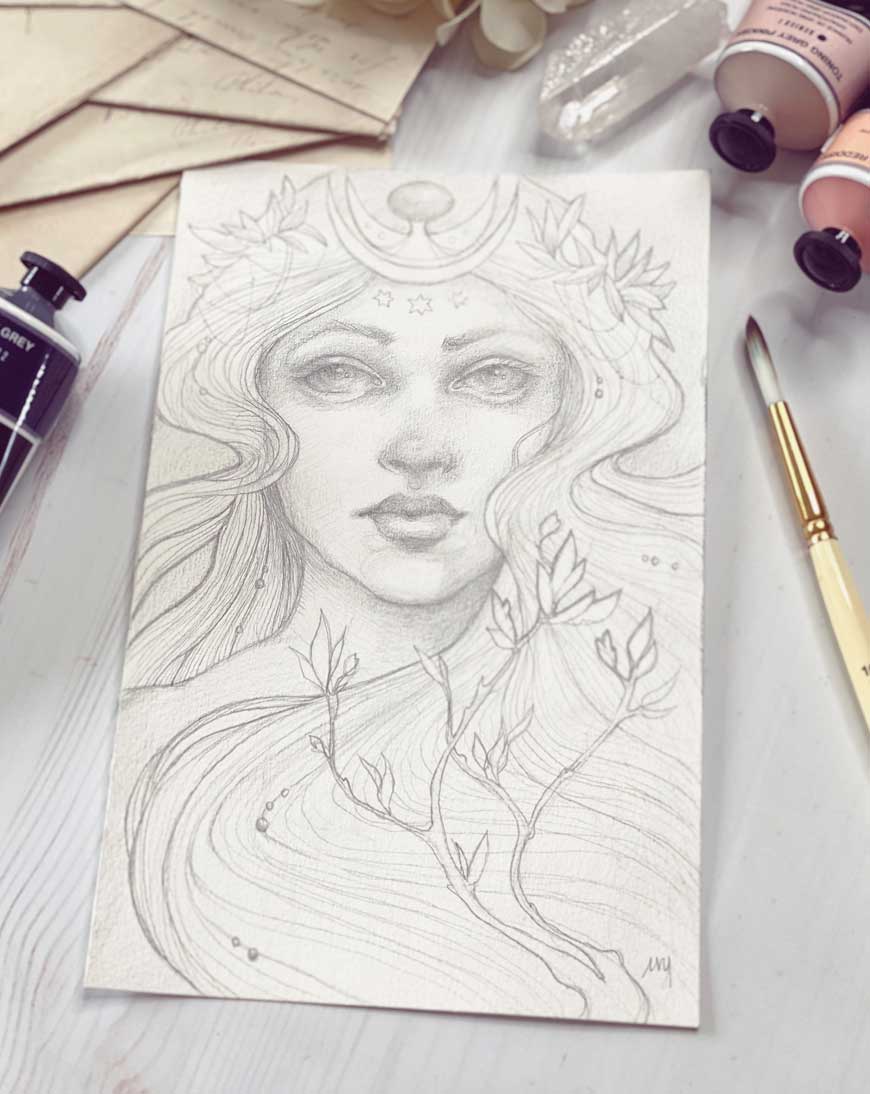
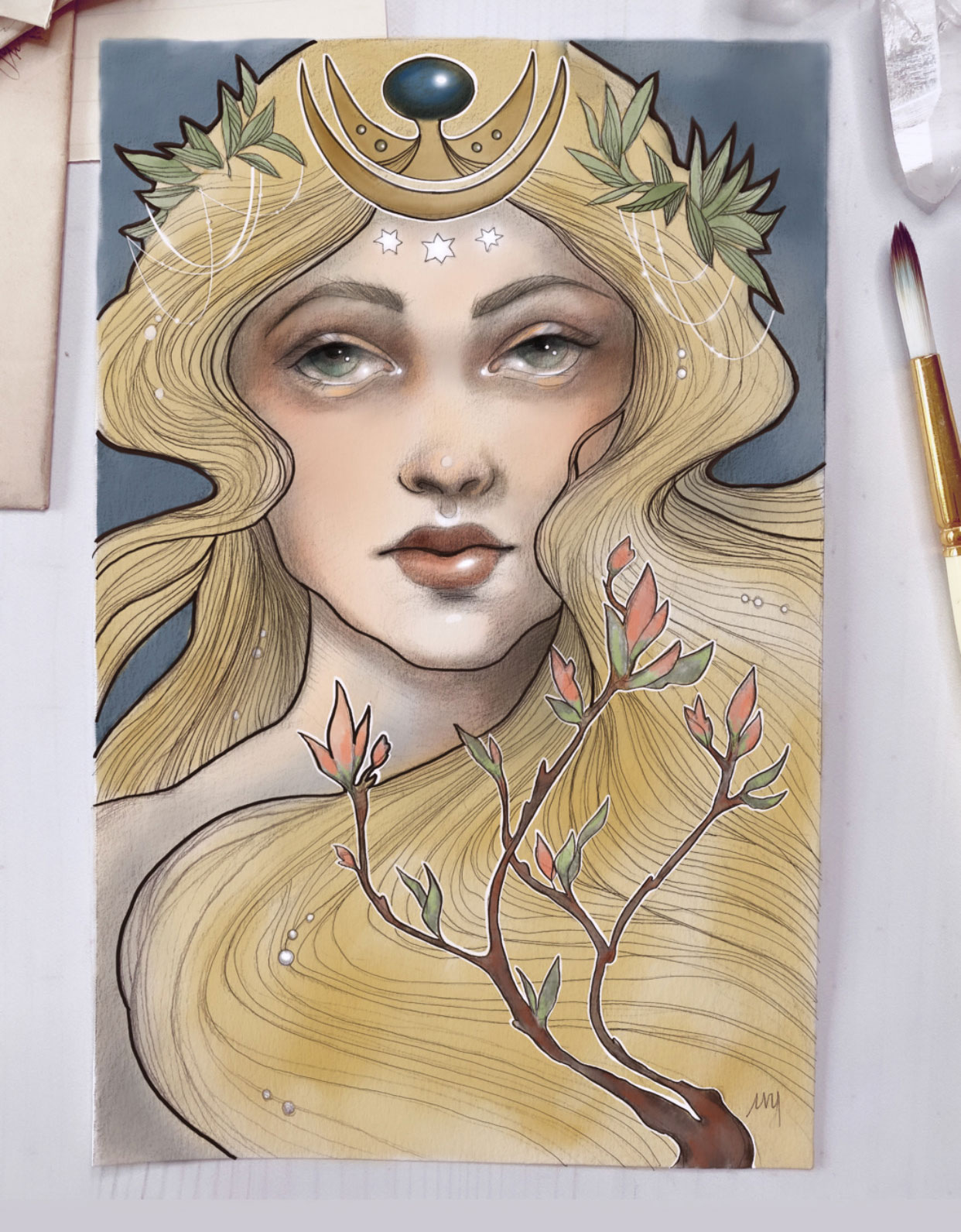
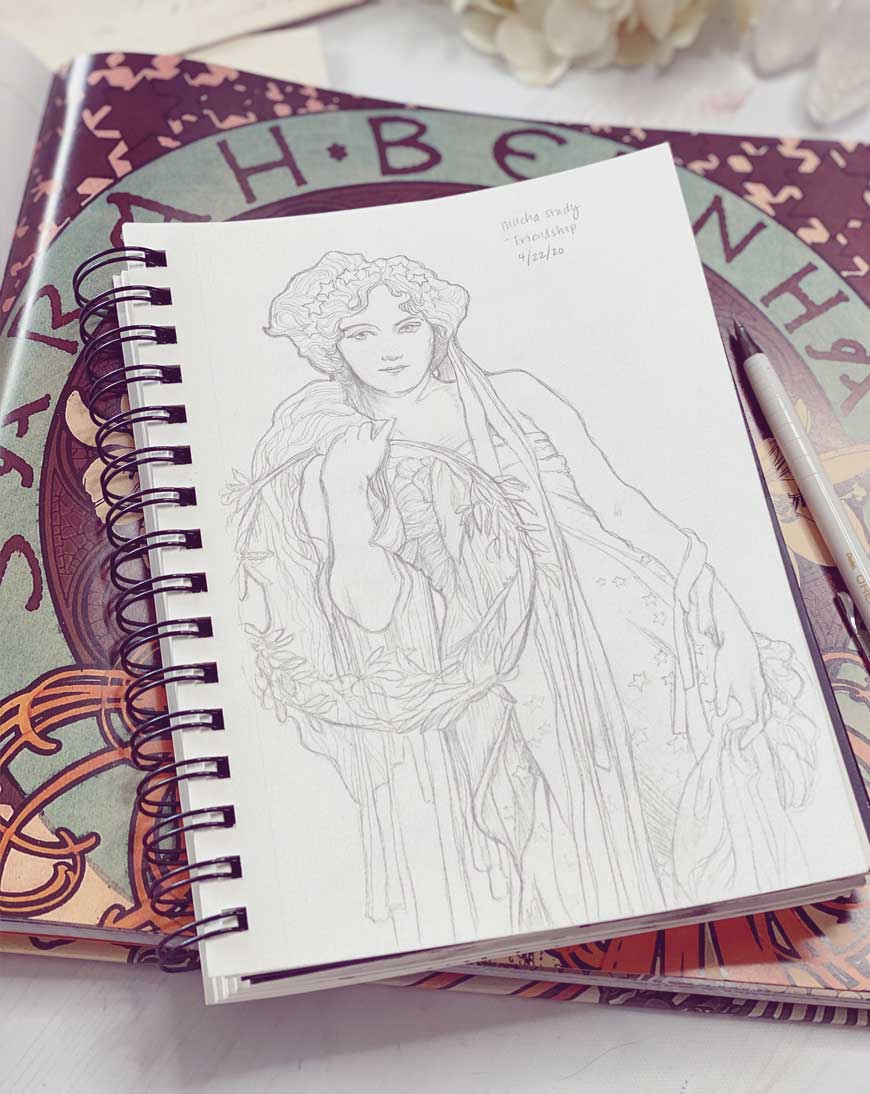
EXPLORATION 2
Master Study
Choose one piece of art created by an artist that you feel influences you. Observe their work and do a study of it. Remember to do a little research and discover what is behind their creations. It’s best to understand the artist’s mind and not only copy their images. Make notes as to why this artist inspires you and what aspects of their work you would like to weave into your own.
EXPLORATION 3
Signature Play
If you haven’t already, go down to our Community Corner and read the article – “What your Signature says about You.” by our creative contributor – Lynne Furrer. It’s a fascinating read and one that has got me thinking about my own signature. I know many new artists hesitate when going to sign their work but I encourage everyone to do this. I agree with Lynne that it sends a message of completeness to the world and stamps the work with your unique final mark. So let’s play with our signature. I remember doing this a lot in art school but haven’t really thought about it much since. Sign your signature on a blank page in your sketchbook. Do you like it? What does it say? Does it look strong or timid? Does it reflect your personality? Play around with different ways of writing your name. Remember there are no rules!
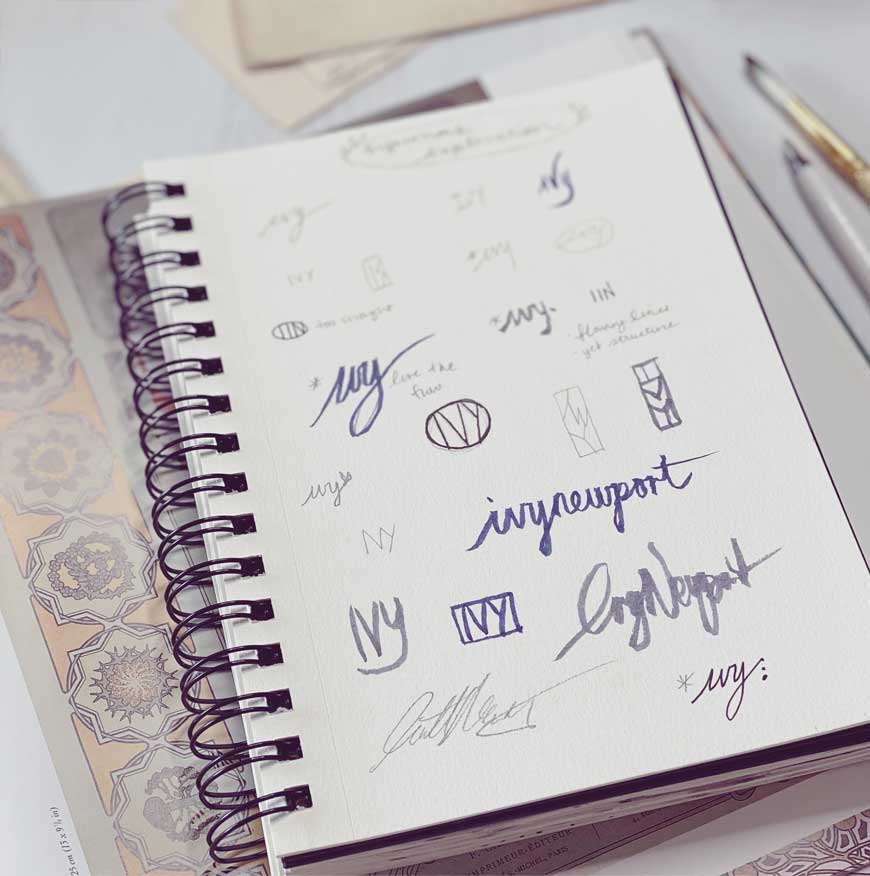
Monthly Lesson
Duality of Self
I’m excited to share this mixed media collage with you ! It’s a bit of a self-discovery journey but please feel free to use other images if you don’t resonate with doing a self-portrait. The principles and techniques I discuss apply to any method of collage-making!
So, grab your favorite old magazines, vintage papers, napkins or other ephemera that you enjoy, your scissors and glue, and let’s have some fun with this collage project! Allow yourself to play and explore combining different elements! That’s the beauty of collage!
Have fun!
STUDIOWORKS
Community Corner
This month, we are excited to add a new section to the journal – The Community Corner! Here, we will feature selected submissions from our wonderful community! Please enjoy!
What Your Art Signature Says About You
BY: LYNNE FURRER
You may not know it, but your signature is the most personal thing about your art. How you sign, where you sign, if you sign, and whether your signature changes in your art journey are fascinating windows into the artist’s soul.
GROWTH AND IDENTITY
Changing your signature as you grow in your art journey is not uncommon. As beginner artists we typically follow what our art teacher does and where she tells us to do it. Aren’t we so surprised we created something worth looking at that we aren’t really haggling over a signature? It’s just another step we learn to do. When the art teacher tells us to sign our full name, we ask “where”? She points to the lower left corner and we write our full name like signing a bank check.
As we build art confidence, we pay more attention to our signatures. We look around and see what others are doing. We try out ways of signing in our journals and doodle pads.
Johann Vermeer changed his signature many times. His given name, Johann, was a popular name used by many other artists of the time. Nicknames and different spellings of Johann were prevalent. To stand out, Vermeer chose a patronym which is a combination of his name and his ancestors. Later he chose just Vermeer, but painted it at least 26 different ways. We can see he was searching for a way to identify his art so everyone would know it was his. You can read more about Vermeer’s signature below…
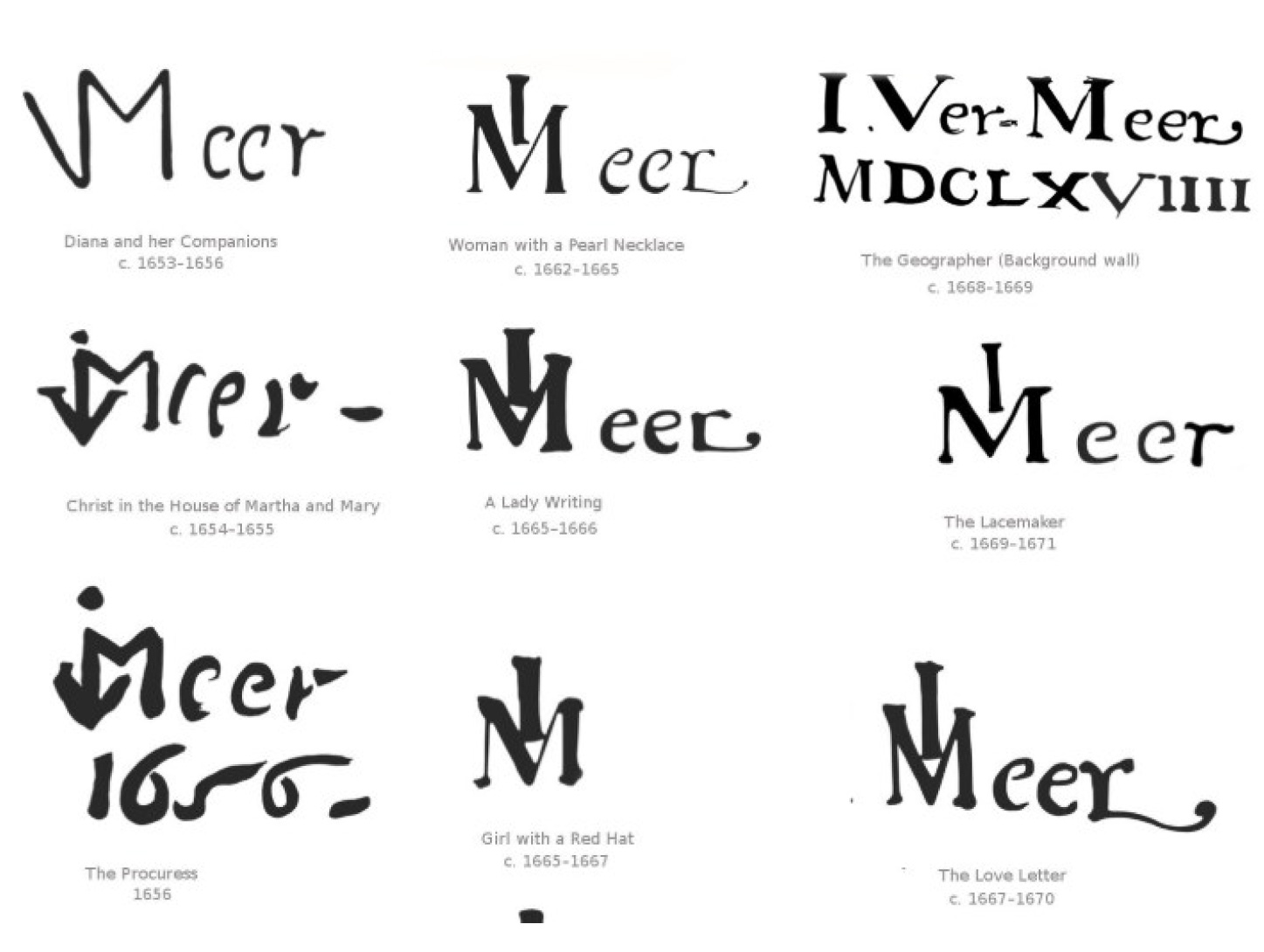
Not everyone changes their signature. Some artists start out with a full name and keep it for a lifetime. But what if you name is Ann Smith? What if you think a full name competes with the art itself? What if you are growing as an artist and you start to think about the relationship of your signature to the style of art you’re creating at each step in your journey? What if you’re just bored with it?
At first, I did just want the art teacher told me and wrote my full name. But it never looked good to me on the art. There was no mystery to it and it didn’t blend well with my style. Aesthetics are very important to me and I don’t want my need to claim the art to outweigh the message of the art. I tried out different styles until I finally found a simple script L that has worked. It’s a nice marriage between my ego’s need for ownership and identification and my heart’s desire to be original and mysterious.
Signature Exploration
Finding your preferred signature is just like finding your style in art. It’s an exploration, a journey or trying something to see if it fits. As you explore new art mediums, painting styles, take classes, all that experience culminates into what you like and don’t like. Give your signature that same consideration. Why? Because your signature is a part of your art; it’s a major part. It sends a message to the viewer that your art is complete and you’re happy with sending that message to the world. Here’s one of my first watercolors where I had already discarded my full name in favor of using only my first name. This was my first 3 months learning watercolor and intuitively writing my full name was onerous and not working. But this signature is unclear and I struggled with claiming ownership. I used this signature for a while, but I also signed my full name on the back of each piece of art.
My art journey took me into other mediums such as Encaustic, mixed media, oil or types of art like Zentangle. I was challenged to keep using the fluid script in my first name. Either the medium would make it difficult or the type of art presented a contrast problem which I didn’t like.
As I worked with all these influences, I ended up with a simple first initial, flowing script “L”, that I use now that works in almost everything I do. I use that script on the front and then I sign the back with permanent ink in my “bank check” signature.
I love how the script “L” becomes part of the composition, but does not compete with it. The best thing is, even if the viewer can’t see it, I know it’s there. It’s mysterious and that’s exactly how I want my art perceived. So, for me, it’s a perfect fit. Did you find the “L”?
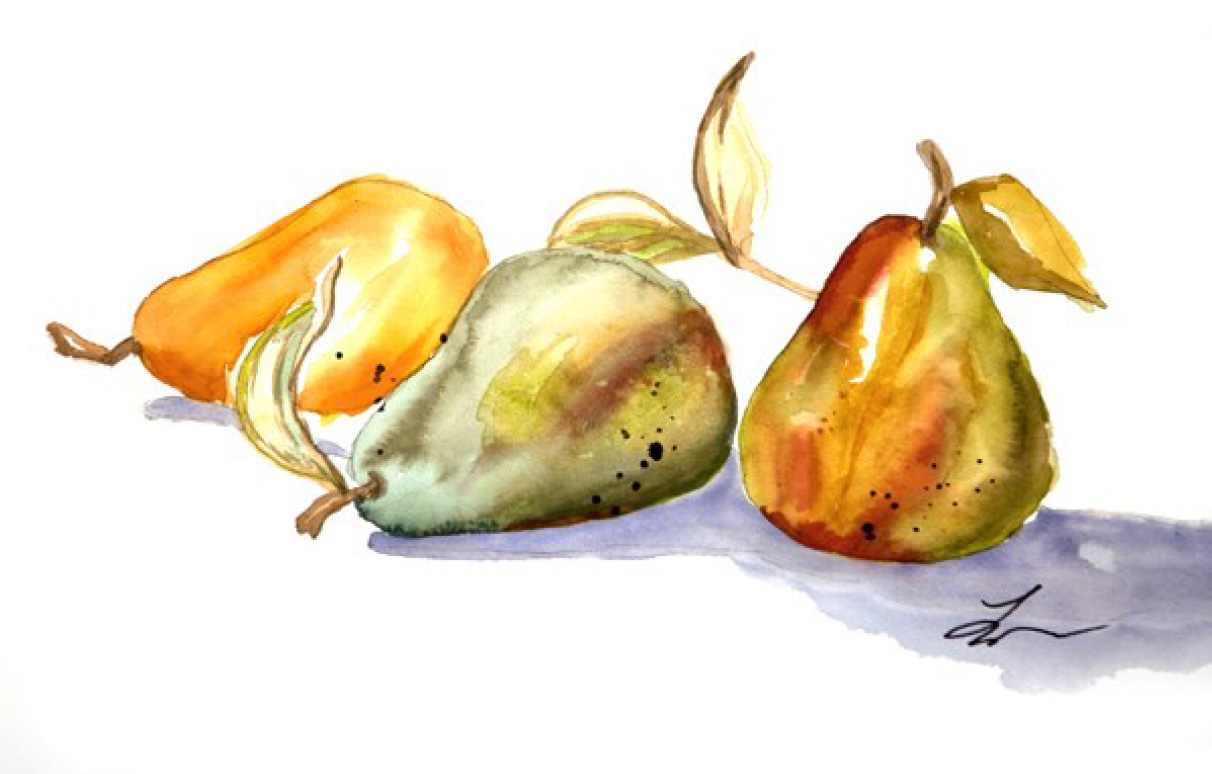
Analyze Your Signature
When we first look at a painting, we are immediately drawn to the area of most contrast. If your signature is highly contrasted with the background or is in a different style than your art (refined vs. loose for example), people will look at your signature first. Do you want them to see your name before exploring your art? Ask yourself if that’s what you really want.
Where you place your signature also matters. In the western world, eye movement studies show that a viewer will look at the right corner before looking elsewhere. Do you sign in the lower right corner? It’s not a wrong choice, but is it the right choice for you?
When you finish with your art, when you feel it’s “done”, you’ve probably not yet signed your art. So, adding your signature is like adding another element to an already finished painting! Whatever you choose to do at this point could alter the balance and/or the composition of an already finished painting. Has this ever occurred to you? If so, this might be something for you to investigate further.
What about how you sign your art? Is it bold? Lots of flourishing letters? Does it match the style of your art? If you painted a beautiful ancient building that’s very refined, very detailed, would you sign in a flowery script? Ask yourself if the style of your signature complements or contrasts with the style of your art.
If you’re contemplating your signature a little differently now and might want to make a change, I highly recommend doodling ideas in a sketchbook or anywhere that’s handy! And check out signatures of other artists as inspiration. There is a website that has collected artists signatures from around the world.
Remember that your signature is the most important element on your art. It tells us so much about you as an artist. Enjoy your journey and never stop exploring!
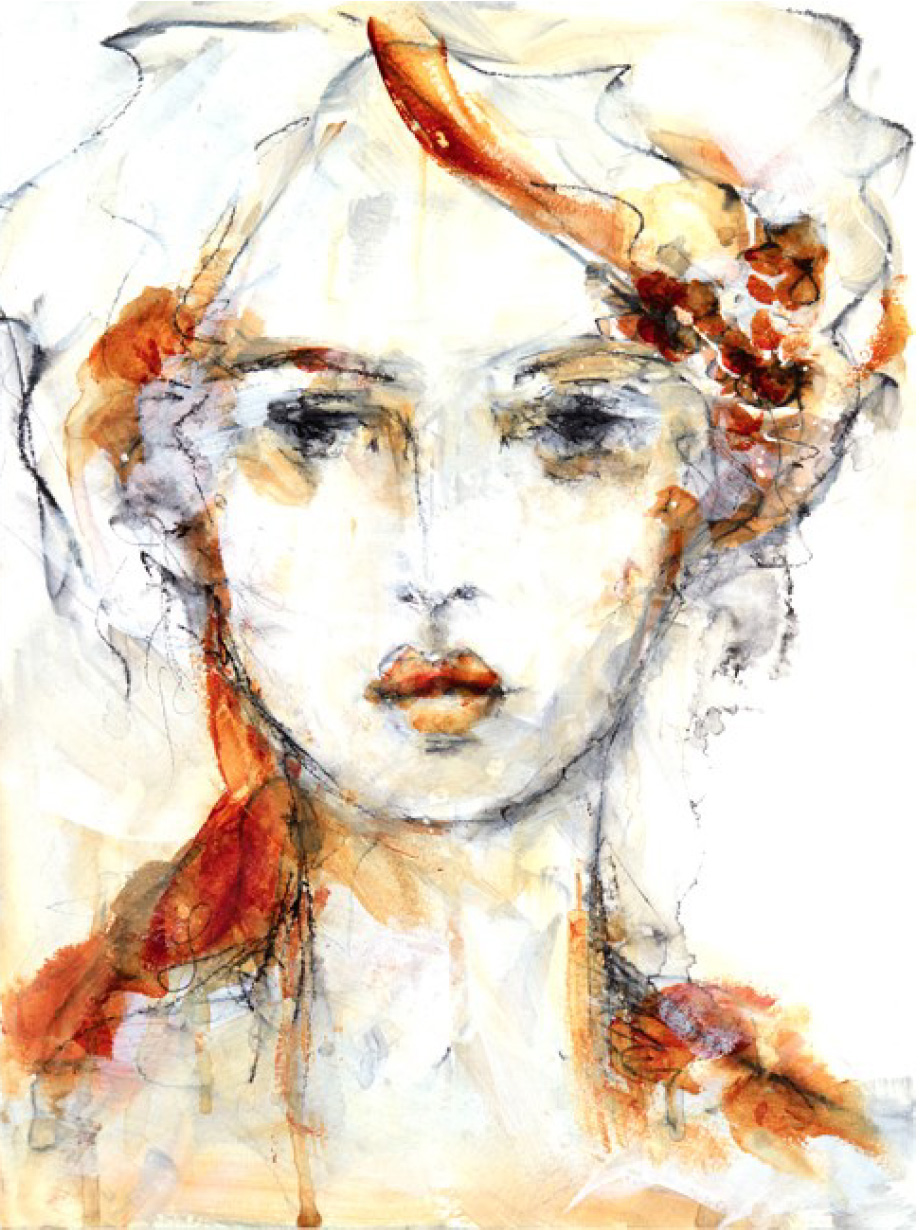
join us in the
Studioworks
creative academy
SAVE UP TO 40% OFF – LIMITED TIME OFFER
Your Studioworks membership unlocks full access to over 180 CREATIVE CLASSES and so much more. No more waitlists or wishing you could join a class.
Plus, you’ll receive UNLIMITED ACCESS to every issue of the Studioworks Journal. Each month you will be supported in your creative journey through teachings I will be sharing with you inside. This specially crafted online magazine will be packed with inspiration, guidance, creative prompts and sketchbook explorations.
Come join this amazing creative community!
STUDIOWORKS PODCAST
issue seventeen
You can also listen to this month’s issue of the Studioworks journal. I find I love listening to books, podcasts and music while I draw, paint or go on a long walk. Enjoy.
Studioworks : issue seventeen

inspiration: curated
One of my favorite things to do is to curate inspiration. From Pinterest boards to books, resources, playlists and more – I love to share anything that might facilitate learning, expansion, and sparks of curiosity! Being an artist, we naturally crave these things so here are some of this month’s picks from me to you.
Books for discovering your creative style
MUSIC PLAYLIST
I had so much fun curating this list. I hope you enjoy!!
PINTEREST BOARDS
INTERESTING ARTICLES & VIDEOS TO CHECK OUT
FAVORITE SUPPLIES THIS MONTH
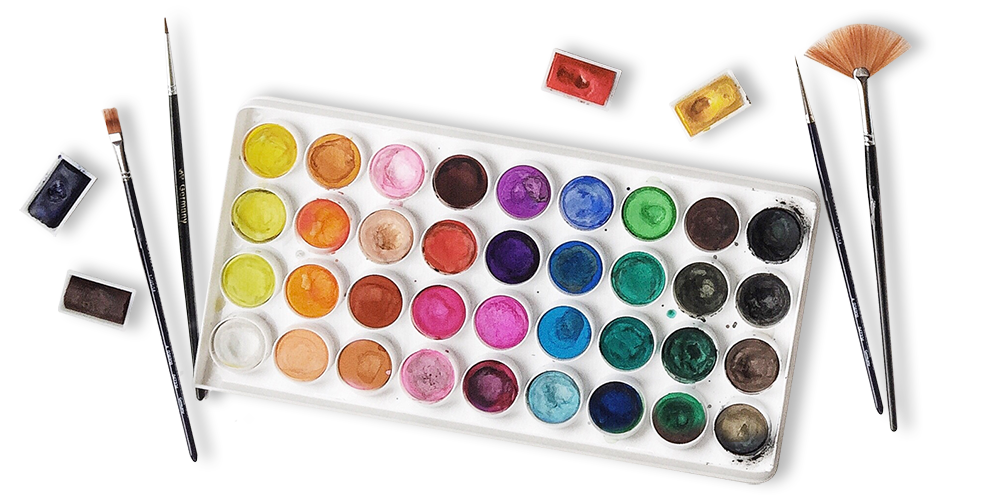
CLASSES TO TRY
These classes carry joy filled learning rooted in nature, art and happiness! I highly recommend checking them out if you haven’t already. Enjoy!

